List of Hypericum species
The genus Hypericum contains approximately 500 species which are divided into 36 sections as described by botanist Norman Robson.[2] This division into distinct sections is largely due to the fact that a genus-wide monograph was performed by Robson in 1977, which allowed for a comprehensive analysis of the genus's taxonomy.[3] A phylogenetic study was more recently completed for the genus, which gave evidence to suggest that the genus Triadenum is a clade within Hypericum and that the genus Thornea is sister to Hypericum. In addition, the study found that about 60% of the sections of Hypericum are monophyletic.[4]
| Hypericum |
.jpg) |
| Hypericum perforatum,
the type species of the genus |
 |
| Hypericum calycinum,
an ornamental plant of the genus |
| Clades[1] |
|
Almost all species of Hypericum are either perennial herbs, shrubs, or small trees, but the genus also contains a small amount of subshrubs and annual herbs.[3] Most of its species contain hypericin or hyperforin and some are used for their healing properties in folk medicine. The species' leaves are always placed opposite, and are normally decussate.[5] Their flowers are generally homostylous, but very few are dimorphically heterostylous. The petals are normally golden yellow or orange, but some are white or cream, and are veined dorsally. They have 4-5 stamen fascicles, 2-5 ovaries, and 2-5 styles. Some species grow capsular fruit which are colored red or blackish.[6]
Hypericum species can be found all over the world in temperate to tropical areas. The genus is most diverse in Turkey (~80 species) and China (~60 species), but can be found across Asia and Europe, in parts of Africa and South America, Australia, and across the United States and Southern Canada.[7] Non-native species have also been introduced into various regions of the United States and Argentina.[8] The genus are generally found in dry, desert areas to being in shallow water, and can be found from warm temperate climates to cold temperate climates.[6]
Some Hypericum species are used as ornamental plants because of their large, spreading flowers.[9] These include H. aegypticum, H. androsaemum, H. calycinum, and H. olympicum. In addition, there are a number of hybrids and cultivars that have been developed for use in horticulture. Some notable cultivars are H. × moserianum, H. 'Hidcote', and H. 'Rowallane'. Several species are also used for their medicinal properties, especially their ability to alleviate mild clinical depression, by drawing out the oily extract from the flowers.[10] H. perforatum is the most potent out of all the species, and is the only species cultivated commercially for herbalism and medicine.[11]
Legend
| Type species[12] | Type species of section |
Type species of genus |
|---|---|---|
| Binomial | The binomial name of the Hypericum species. | |
| Common Name | The name that the species is commonly called | |
| Type | The type of plant that the species is described as | |
| Distribution | The country or region where the species is most densely found | |
Sect. Adenosepalum
Adenosepalum Spach is divided into four subsections: Adenosepalum, Aethiopica, Caprifolia, and the Huber-Morathii Group. These subsections contain eight, seven, eleven, and five species, respectively, giving the section Adenosepalum a total of thirty-one species. In addition, Adenosepalum contains two Nothospecies: H. × joerstadii and H. pubescens × tomentosum. H. annulatum has three distinct subspecies.
Adenosepalum is made up of primarily perennial herbs, and also includes shrubs and shrublets. Its species grow to be approximately 2.5 meters tall, and are generally deciduous. Species in Adenosepalum are glabrous or have simple hairs, and almost always have dark black glands on their leaves, sepals, and rarely on their petals and stems. Their leaves are placed opposite and have no ventral glands. Their flowers are stellate or homostylous. They have 5 sepals, 5 stamen fascicles, and 5 petals.[6]
| Binomial | Common Name | Type | Distribution | Image | References |
|---|---|---|---|---|---|
| Subsection Adenosepalum | |||||
| H. annulatum
Moris (1827) |
Perennial herb | Balkans, Saudi Arabia, East Africa | [13][14][15][16][17] | ||
| H. athoum
Boiss. & Orph. (1867) |
Perennial herb | 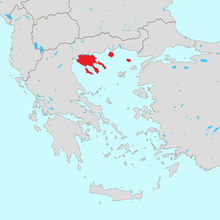 |
.jpg) |
[18][13][14][19][20] | |
| H. atomarium
Boiss. (1827) |
Perennial herb | Greece, Turkey, Portugal (Naturalized) | .jpg) |
[21][22][18][13][23] | |
| H. cuisinii
Barbey (1885) |
Perennial herb | Europe | [21][18][13][24][25] | ||
| H. delphicum
Boiss. & Heldr. (1854) |
Perennial herb |  |
.jpg) |
[21][18][13][14][24] | |
| H. lanuginosum
Lam. (1797) |
Perennial herb | Middle East, Turkey, Cyprus | [26][2][27][28][29] | ||
| H. montanum
L. (1755) |
Pale St. John's Wort | Perennial herb |  |
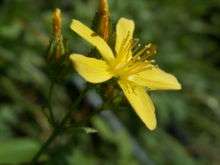 |
[21][14][19][30][31] |
| H. reflexum
L.f. (1782) |
Shrub | 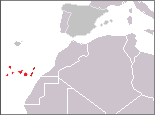 |
[32][33][34][15][35] | ||
| Subsection Aethiopica | |||||
| H. abilianum
N.Robson (1980) |
Subshrub | 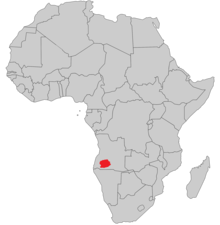 |
[8][22][35][36][23] | ||
| H. aethiopicum
Thunb. (1800) |
Perennial herb | Southern Africa | [37][35][36][38][39] | ||
| H. afrum
Lam. (1797) |
Perennial herb | Tunisia, Algeria | .jpg) |
[40][18][33][35][23] | |
| H. conjungens
N.Robson (1958) |
Shrub/subshrub |  |
.jpg) |
[26][35][23][41][42] | |
| H. glandulosum
Aiton (1789) |
Malfurada del Monte | Shrub | 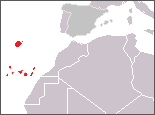 |
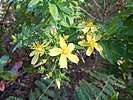 |
[32][43][24][44] |
| H. kiboënse
Oliv. (1887) |
Shrub/Subshrub |  |
[45][46][24] | ||
| Subsection Caprifolia | |||||
| H. caprifolium
Boiss. (1838) |
Perennial herb | 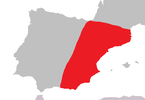 |
.jpg) |
[21][18][13][15][35] | |
| H. coadunatum
Chr. Sm. (1825) |
Subshrub/Perennial herb |  |
.jpg) |
[32][33][15][35][44] | |
| H. collenettiae
N.Robson (1993) |
Subshrub/Perennial herb | Saudi Arabia | .jpg) |
[26][2][23][24] | |
| H. naudinianum
Coss. & Durieu (1855) |
Perennial herb | Morocco, Algeria | [45][35][43][24] | ||
| H. psilophytum
(Diels) Maire (1935) |
Perennial herb | Morocco, Algeria | [8][33][35][24] | ||
| H. pubescens
Boiss. (1838) |
Perennial herb | Southern Iberia, North Africa | [21][22][47][35][43] | ||
| H. scruglii
Bacch., Brullo & Salmeri (2010) |
Perennial herb | Sardinia | [45][24][48][49] | ||
| H. sinaicum
Hochst. ex Boiss. (1867) |
Perennial herb | Egypt, Arabian Peninsula | [45][33][29][24][50] | ||
| H. somaliense
N.Robson (1958) |
Perennial herb |  |
[8][35][24] | ||
| H. tomentosum
L. (1753) |
Perennial herb | 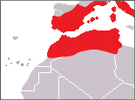 |
 |
[21][33][34][15][16] | |
| Huber-Morathii Group | |||||
| H. decaisneanum
Coss. & Daveau (1889) |
Perennial herb |  |
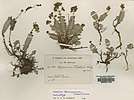 |
[45][18][33][35][24] | |
| H. formosissimum
Takht. (1940) |
Perennial herb | Armenia, Azerbaijan, Turkey | 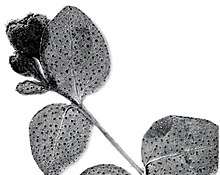 |
[26][22][27][24][25] | |
| H. huber-morathii
N.Robson (1967) |
Perennial herb |  |
 |
[51][52][33][24][25] | |
| H. minutum
P.H.Davis & Poulter (1954) |
Perennial herb |  |
[8][2][27][24][25] | ||
| H. sechmenii
Ocak & O.Koyuncu (2009) |
Perennial herb | 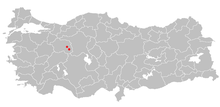 |
[53][24][54][26][25] | ||
Sect. Adenotrias
Adenotrias (Jaub. & Spach) R. Keller contains three species: H. aciferum, H. aegypticum, and H. russeggeri. Its type species is H. russeggeri. It is not divided into any subsections. H. aegypticum has three subspecies: H. aegypticum aegypticum L., H. aegypticum maroccanum (Pau) N.Robson, and H. aegypticum webbii (Spach) N.Robson.[55]
Adenotrias contains shrubs and shrublets. Its species can grow to be up to 2 meters tall. Its species are glabrous, but have no dark glands. Their leaves are lined and glandular, and are cortex green. Their flowers are almost tubular, and are heterostylous. They have 5 sepals, 5 petals, and 3 stamen fascicles.[6]
| Binomial | Common Name | Type | Distribution | Image | References |
|---|---|---|---|---|---|
| H. aciferum
(Greuter) N.Robson (1967) |
Shrublet |  |
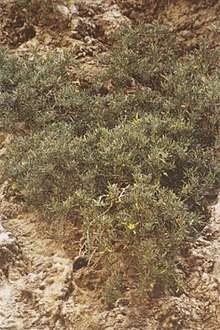 |
[8][50][21][18][13] | |
| H. aegypticum
L. (1753) |
Egyptian St. John's Wort | Shrub/shrublet | North Africa, Greece, Sardinia | 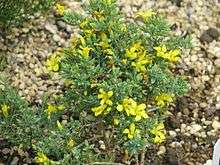 |
[56][47][57][58][59] |
| H. russeggeri
(Fenzl) R.Keller |
Shrub/shrublet | Turkey, Syria |  |
[50][45][33][27][25] |
Sect. Androsaemum
Androsaemum (Duhamel) Godron contains four species: H. androsaemum, H. foliosum, H. grandifolium, and H. hircinum. In addition, Androsaemum contains one Nothospecies: H. × inodorum. It is not divided into subsections. Its type species is H. androsaemum. One of its species, H. grandifolium, has five different subspecies. The section's species are often collectively referred to as Tutsan.
Androsaemum contains shrubs that grow to be from 0.3–2 meters tall. Its species are deciduous and glabrous, but have no dark glands. Their leaves are opposite, decussate, free, and are a pale color. Every species has 20 flowers, branching out from 2 separate nodes, which are homostylous. They have 5 sepals, 5 petals, and 5 stamen fascicles.[6]
| Binomial | Common Name | Type | Distribution | Image | References |
|---|---|---|---|---|---|
| H. androsaemum
L. (1753) |
Sweet-Amber | Shrub | Southern Europe, North Africa | 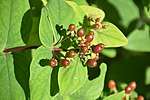 |
[60][61][62][63][64] |
| H. foliosum
Aiton (1789) |
Azorean St. John's Wort | Shrub | Portugal (The Azores) | [21][40][43][45] | |
| H. grandifolium
Choisy (1821) |
Malfurada | Shrub |  |
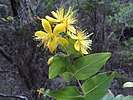 |
[62][65][66][67][68] |
| H. hircinum
L. (1753) |
Stinking Tutsan | Shrub | France, Iberia, Italy, Middle East, North Africa | [28][29][66][69][70] |
Sect. Arthrophyllum
Arthrophyllum Jaub. & Spach contains five species, and is not divided into any subsections. Its type species is H. rupestre. Arthrophyllum is most closely related to Webbia.[71]
Arthrophyllum contains shrubs that grow to be approximately 0.9 meters tall and are deciduous but never leafless. Species in Arthrophyllum are glabrous, with reddish to dark glands. Their leaves are placed opposite and are either decussate, sessile, free, or perfoliate and have no ventral glands. They are 40-flowered, and their flowers are stellate and homostylous. They have 5 sepals that lack marginal glands. Arthrophyllum's species also have 5 petals and 3 stamen fascicles, each with 20-40 stamens. Their seeds are narrow and cylindrical.[6]
| Binomial | Common Name | Type | Distribution | Image | References |
|---|---|---|---|---|---|
| H. cardiophyllum
Boiss. (1867) |
Shrub |  |
 |
[72][50][18][27][23] | |
| H. nanum
Poir. (1814) |
Shrub |  |
 |
[72][50][27][29][43] | |
| H. pamphylicum
N.Robson & P.H.Davis (1980) |
Shrub |  |
 |
[50][45][18][27][24] | |
| H. rupestre
Jaub. & Spach (1842) |
Shrub |  |
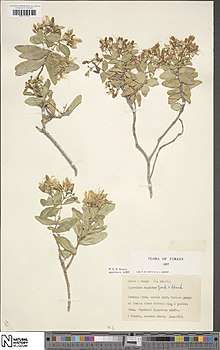 |
[50][51][33][27][35] | |
| H. vacciniifolium
Hayek & Siehe (1914) |
Shrub |  |
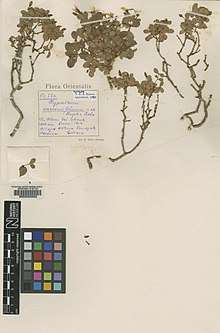 |
[50][22][27][19][24] |
Sect. Ascyreia
Ascyreia Choisy contains exactly 50 species and also includes four nothospecies. The section is one of the largest in the genus that is not divided into any subsections. Its type species is H. calycinum. The section is synonymous with Norysca Spach..[7]
Ascyreia is made up of mostly shrubs or shrublets, but also contains a few trees. Its species generally grow to be from 4–5 meters tall. Some of the species are evergreen, but most are deciduous. They are glabrous, and lack dark glands. Their leaves are opposite, decussate, and free. The section's species have anywhere from 1-25 flowers, which are stellate and homostylous. They have five sepals, which are free. They also have five petals and five stamen fascicles, which each have 20-100 stamens. Their seeds are cylindric or ellipsoid, and some are laterally winged.[6]
| Binomial | Common Name | Type | Distribution | Image | References |
|---|---|---|---|---|---|
| H. acmosepalum
N.Robson (1970) |
Shrub | China | [14][66][23][73][7] | ||
| H. addingtonii
N.Robson (1985) |
Addington's St. John's Wort | Shrub | China | [56][14][66][74][73] | |
| H. augustinii
N.Robson (1970) |
Augustine's St. John's Wort | Shrub | China |  |
[14][66][23][73][7] |
| H. beanii
N.Robson (1970) |
Shrub | China | [75][76][34][15][77] | ||
| H. bellum
H.L.Li (1944) |
Shrub | China | [63][14][61][78][66] | ||
| H. calycinum
L. (1767) |
Great St. John's Wort
Aaron's Beard Rose of Sharon |
Shrub | Bulgaria, Turkey |  |
[56][63][79][61][64] |
| H. choisianum
Wall. ex N.Robson (1973) |
Shrub | China, India, Pakistan |  |
[80][63][14][66][73] | |
| H. cohaerens
N.Robson (1985) |
Shrub | China | [73][7][24] | ||
| H. cordifolium
Choisy (1824) |
Shrub | Nepal | [63][2][66][23][43] | ||
| H. curvisepalum
N.Robson (1985) |
Shrub | China | [14][73][7] | ||
| H. elatoides
R.Keller (1904) |
subshrub | China | [69][73][7] | ||
| H. forrestii
(Chitt.) N.Robson (1970) |
Forest Tutsan | Shrub | China, Burma | [80][14][78][81][77] | |
| H. gaitii
Haines (1919) |
Shrub | India | [51][82][63] | ||
| H. gracilipes
Stapf ex C.E.C.Fisch. (1940) |
Shrub | India, Bangladesh | [8][24] | ||
| H. griffithii
Hook.f. & Thomson ex Dyer (1874) |
Shrub | Bhutan, India | [83][84][63][7] | ||
| H. henryi
H.Lév. & Vaniot (1908) |
Shrub | China, Southeast Asia | [56][73][7][24] | ||
| H. hookerianum
Wight & Arn. (1834) |
Hooker's St. John's Wort | Shrub | East and South Asia | 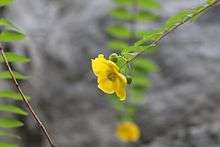 |
[76][63][62][14][43] |
| H. kouytchense
H.Lév. (1904) |
Shrub | China | .jpg) |
[56][61][64][73][85] | |
| H. lacei
N.Robson (1985) |
Shrub | Myanmar | [51][22][24] | ||
| H. lagarocladum
N.Robson (1985) |
Shrub | China | [2][73][7][24] | ||
| H. lancasteri
N.Robson (1985) |
Shrub | China |  |
[14][73][7][24] | |
| H. leschenaultii
Choisy (1824) |
Shrub/small tree | Indonesia | [45][66][15][43][86] | ||
| H. lobbii
N.Robson (1970) |
Shrub | India | [8][66][24] | ||
| H. longistylum
Oliv. |
|||||
| H. maclarenii
N.Robson (1985) |
Shrub | China | [14][73][7][24] | ||
| H. monogynum
L. (1763) |
Shrub | China (Southeast), Taiwan |  |
[63][78][66][73][87] | |
| H. mysurense
Wall. ex Wight & Arn. (1934) |
Shrub | India (South), Sri Lanka | .jpg) |
[63][2][46][24] | |
| H. oblongifolium
Choisy (1821) |
Pendant St. John's Wort | Shrub | Pakistan, India, Nepal |  |
[80][63][14][15][43] |
| H. pachyphyllum
Collett & Hemsl. (1890) |
Shrub/undershrub | Myanmar | [51][43][24] | ||
| H. patulum
Thunb. (1784) |
Goldencup St. John's Wort
Yellow Mosqueta |
Shrub | China | [34][88][61][78] | |
| H. podocarpoides
N.Robson (1977) |
Shrub | Nepal, India | [63][24] | ||
| H. prattii
Hemsl. (1892) |
Shrub | China | [73][7][24] | ||
| H. pseudohenryi
N.Robson (1970) |
Irish Tutsan | Shrub | China |  |
[81][89][90][31] |
| H. reptans
Hook.f. & Thomson ex Dyer (1874) |
Shrublet | China, Burma, India, Nepal | .jpg) |
[63][66][19][73][7] | |
| H. sherriffii
N.Robson & D.G.Long (1983) |
Shrub | Bhutan | [40][22][24] | ||
| H. siamense
N.Robson (1985) |
Shrub | Thailand | [45][2][24] | ||
| H. stellatum
N.Robson (1970) |
Shrub | China | [63][66][73][7][24] | ||
| H. subsessile
N.Robson (1985) |
Shrub | China | [14][66][73][7][24] | ||
| H. tenuicaule
Hook.f. & Thomson ex Dyer (1874) |
Shrub | Bhutan, India, Nepal | [51][63][24] | ||
| H. uralum
Buch.-Ham. ex D.Don (1823) |
Shrub | China, Burma, India |  |
[76][63][90][73][91] | |
| H. wardianum
N.Robson (2005) |
Shrub | China, Burma | [22][73][7][24] | ||
| H. williamsii
N.Robson (1977) |
Shrub | Nepal | [45][63][24] | ||
| H. wilsonii
N.Robson (1970) |
Shrub | China | [2][66][15][73][7] |
Sect. Brathys
Brathys (Mutis ex L.f.) Choisy is the largest section in Hypericum. It is divided into four subsections: Brathys, Phellotes, Spachium, and Styphelioides. Brathys contains 38 species and the type species, H. juniperinum. Phellotes contains 32 species, Spachium contains 14 species, and Styphelioides contains just 2 species. In total, the section contains 86 species.
Brathys contains a wide variety of plants, including small trees, shrubs, shrublets, and herbs. The largest species in the section grow to be 6 meters tall, and are evergreen. Its species are glabrous—though a few have simple hairs—and lack any dark glands. Their stems are either 4 or 6-lined, and are compressed when the plant is young, but later become terete. Their leaves are placed opposite, are decussate and sessile, and have dense marginal glands. All the species have either one flower on the uppermost node of the plant or 2-15 flowers branching from the uppermost node and from lower secondary nodes. The flowers are stellate or sometimes obconic, and are homostylous. The species have 5 petals which are persistent. They have 5 stamen fascicles which contain anywhere from 1-50 stamens each, formed in a tight ring, to give the plants a total of anywhere from 5-250 stamens. The plants have 5 ovaries, 5 sepals, and 3-5 styles.[6]
| Binomial | Common Name | Type | Distribution | Image | References |
|---|---|---|---|---|---|
| Subsection Brathys | |||||
| H. aciculare
Kunth (1821) |
Shrub | Peru, Ecuador | [8][92][88][23][24] | ||
| H. andinum
Gleason (1929) |
Shrub/shrublet | [45][34][92][23][93] | |||
| H. baccharoides
Cuatrec. (1959) |
Shrub | Colombia, Venezuela | [22][23][24] | ||
| H. bolivaricum
N.Robson (1987) |
Shrub | Colombia | [92][23][24] | ||
| H. bryoides
Gleason (1929) |
subshrub | Colombia | [2][23][24] | ||
| H. caracasanum
Willd. |
Shrub/shrublet | Venezuela | [23][24] | ||
| H. cardonae
Cuatrec. |
Shrub/shrublet | Costa Rica, Venezuela, Colombia | [22][23][24] | ||
| H. cassiopiforme
N.Robson |
Shrub | Peru | [2][23] | ||
| H. costaricense
N.Robson |
Costa Rica St. John's Wort | Shrub/shrublet | Colombia, Costa Rica |  |
[26][23] |
| H. decandrum
Turcz. |
Shrub/shrublet | Ecuador, Peru | [88] | ||
| H. harlingii
N.Robson |
Shrub | Ecuador | [88] | ||
| H. horizontale
N.Robson |
Shrublet | Colombia | [24] | ||
| H. jaramilloi
N.Robson |
Shrub | Costa Rica, Colombia | |||
| H. juniperinum
Kunth |
Shrub/shrublet | Colombia, Venezuela | .jpg) |
[26] | |
| H. lancifolium
Gleason |
Shrub | Colombia, Venezuela | [2] | ||
| H. lancioides
Cuatrec. |
Shrub | Colombia, Ecuador, Venezuela | [8][92][88] | ||
| H. llanganaticum
N.Robson |
Shrub | Ecuador | [40][8][88] | ||
| H. magdalenicum
N.Robson |
Shrub/small tree | Colombia, Venezuela | [45] | ||
| H. magniflorum
Cuatrec. |
Shrub | Colombia, Venezuela | [22] | ||
| H. marahuacanum
N.Robson |
Shrub | Colombia, Venezuela | |||
| H. mexicanum
L. |
Shrub/shrublet | Colombia, Venezuela | [26][43] | ||
| H. millefolium
Urb. & Ekman |
Shrub | Haiti | |||
| H. parallelum
N.Robson |
Shrub | Colombia | |||
| H. pimeleoides
Planch. & Linden ex Triana & Planch. |
Shrub | Colombia | [2] | ||
| H. prietoi
N.Robson (1945) |
Shrub | Ecuador | [40][88] | ||
| H. prostratum
Cuatrec. |
Shrub/Shrublet | Colombia | [22] | ||
| H. pycnophyllum
Urb. |
Shrub | Dominican Republic | |||
| H. recurvum
N.Robson |
Shrub | Peru | [92] | ||
| H. ruscoides
Cuatrec. |
Shrub | Colombia, Ecuador | [88] | ||
| H. selaginella
N.Robson |
Shrublet | Colombia | [8] | ||
| H. sprucei
N.Robson |
Shrub | Ecuador | [45][92][88] | ||
| H. strictum
Kunth |
Shrub | Colombia | [94][88] | ||
| H. struthiolifolium
Juss. |
Shrub | Peru | [26][92][43] | ||
| H. stuebelii
Hieron. |
Shrub | South America | [2] | ||
| H. tetrastichum
Cuatrec. |
Shrub/shrublet | Colombia | [8] | ||
| H. valleanum
N.Robson |
Shrub | Colombia | [22] | ||
| H. wurdackii
N.Robson |
Shrub | Peru | |||
| Subsection Phellotes | |||||
| H. acostanum
Steyerm. ex N.Robson |
Shrub | Ecuador | [8][40][88][23] | ||
| H. asplundii
N.Robson |
Shrublet | Ecuador | [40][88][23] | ||
| H. callacallanum
N.Robson |
Shrub | Peru | [40][23] | ||
| H. carinosum
R. Keller |
Shrub | Colombia, Venezuela | [26][23] | ||
| H. castellanoi
N.Robson |
Shrub/shrublet | Colombia, Venezuela | [2][23] | ||
| H. cuatrecasii
Gleason |
Shrub | Colombia | |||
| H. espinalii
N.Robson |
Shrub | Colombia | |||
| H. garciae
Pierce |
Shrub | Colombia, Venezuela | [8] | ||
| H. gladiatum
N.Robson |
Shrub | Colombia | |||
| H. goyanesii
Cuatrec. |
Shrub | Colombia | [2] | ||
| H. hartwegii
Benth. (1843) |
Shrub | Ecuador | [40][88] | ||
| H. humboldtianum
Steud. (1840) |
Shrub/shrublet | Colombia, Venezuela | [45][43] | ||
| H. irazuense
Kuntze ex N.Robson |
Shrub/small tree | Costa Rica, Panama |  |
[26][95] | |
| H. laricifolium
Juss. |
Shrub/small tree | Colombia, Ecuador, Peru, Venezuela | .jpg) |
[8][92][88][43][96] | |
| H. loxense
Benth. |
Shrub/shrublet | Ecuador, Peru | [22][92][88] | ||
| H. lycopodioides
Triana & Planch. |
Shrub | Colombia | |||
| H. maguirei
N.Robson |
Shrub | Ecuador | [40][88] | ||
| H. martense
N.Robson |
Shrublet | Colombia | [34] | ||
| H. matangense
N.Robson (1990) |
Shrub | Ecuador | [40][88] | ||
| H. myricariifolium
Hieron. |
Shrub | Colombia | .jpg) |
[8] | |
| H. papillosum
N.Robson |
Shrub | Colombia | [22] | ||
| H. paramitanum
N.Robson |
Shrub/small tree | Venezuela | [2] | ||
| H. phellos
Gleason (1929) |
Shrub/small tree | Colombia, Venezuela | 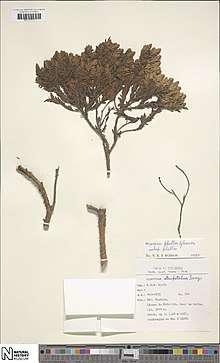 |
[8] | |
| H. piriai
Arechav. |
Atlantic St. John's Wort | Shrub/perennial herb | Brazil, Uruguay | [45][24] | |
| H. quitense
R.Keller |
Shrub/shrublet | Ecuador | [40][88] | ||
| H. radicans
N.Robson |
Shrublet | Colombia | [22] | ||
| H. roraimense
Gleason |
Shrub | Venezuela | [95] | ||
| H. sabiniforme
Trevis. |
Shrub | Colombia | [26] | ||
| H. simonsii
N.Robson |
Shrub (?) | Colombia | [2] | ||
| H. stenopetalum
Turcz. |
Shrub/small tree | Colombia, Venezuela | [95] | ||
| H. thuyoides
Kunth |
Shrub/small tree | Colombia |  |
[43] | |
| H. woodianum
N.Robson |
Shrub | Colombia | [8] | ||
| Subsection Spachium | |||||
| H. arbuscula
Standl. & Steyerm. |
Subshrub/shrublet | Mexico, Guatemala | [22][34][23] | ||
| H. beamanii
N.Robson |
Shrublet | Guatemala | [23] | ||
| H. chamaemyrtus
Triana & Planch. |
Subshrub | Colombia, Venezuela | [2][23] | ||
| H. cymobrathys
N.Robson |
Shrub | Colombia | |||
| H. dichotomum
Lam. |
Perennial herb | Dominican Republic, Haiti | [97][96] | ||
| H. diosmoides
Griseb. |
Puerto Rico St. John's Wort | Perennial herb | Caribbean | [75][34][43][98] | |
| H. drummondii
(Grev. & Hook.) Torr. & A. Gray |
Drummond's St. John's Wort
Nits and Lice |
Annual herb |  |
[75][99][100][101][102] | |
| H. eastwoodianum
I.M.Johnst. |
Eastwood's St. John's Wort | Subshrub/shrublet | Mexico | [26][34] | |
| H. fuertesii
Urb. |
Shrublet/perennial herb | Dominican Republic, Haiti | [22] | ||
| H. galinum
S.F. Blake |
Shrublet | Mexico | [8] | ||
| H. gentianoides
(L.) Britton, Sterns & Poggenb. |
Pineweed
Orangegrass |
Annual herb | Canada, United States, South America |  |
[103][104][100][102][31] |
| H. gnidioides
Seem. |
Subshrub/shrublet | Costa Rica, Honduras, Panama | [22][92][43][95] | ||
| H. peninsulare
Eastw. |
Subshrub/perennial herb | Mexico | [45][34] | ||
| H. rubritinctum
N.Robson |
Shrublet | Mexico | [34] | ||
| Subsection Styphelioides | |||||
| H. styphelioides
A.Rich. |
Shrub | Cuba | [26][92] | ||
| H. terrae-firmae
Sprague & L.Riley |
Shrub/small tree | Belize |  |
[8][34][95] | |
Sect. Bupleuroides
Bupleuroides Stef. contains one species, H. bupleuroides, which shares the name of the section.
H. bupleuroides is a perennial herb that grows to be approximately 75 centimeters tall. The species' stems sprout from branching rhizomes, and are glabrous and lack dark glands. The leaves are placed opposite and are terete and are perfoliate. It has anywhere from 4-25 flowers that branch from 1-5 nodes and are stellate and homostylous and have 5 petals. There are either 3 or 4 stamen fascicles with 20-25 stamens each. The species has 5 sepals, 3 ovaries, and 3 styles.[6]
| Binomial | Common Name | Type | Distribution | Image | References |
|---|---|---|---|---|---|
| H. bupleuroides
Stef. (1852) |
Perennial herb | Turkey, Russia | [90][51][45][18][105] |
Sect. Campylopus
Campylopus Boiss. contains one species, H. cerastioides, which is also frequently called H. campylopus. This species is widely cultivated for its vibrant flowers. The section is most closely related to Olympia and Oligostema which are its sister taxa.[105]
Hypericum cerastioides is a perennial herb that grows to be 6-25 centimeters tall, and normally grows upright but sometimes grows prostrate along the ground. It can have a few or numerous stems from plant to plant, and is normally unbranched or branched only below the inflorescence. The stems are white and pubescent with 5-35 millimeter long internodes that can be either shorter or longer than the leaves. It is 1-5 flowered with flowers 2-5 centimeters in diameter. The petals are golden yellow without a tint of red and number 2 times the number of sepals in the inflorescence, and there are 60-100 stamens.
| Binomial | Common Name | Type | Distribution | Image | References |
|---|---|---|---|---|---|
| H. cerastioides
N.Robson (1967) |
Subshrub/Perennial herb | 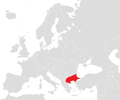 |
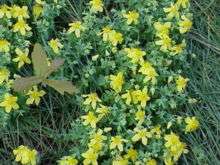 |
[76][13][66][90][105] |
Sect. Camplyosporus
Campylosporus (Spach) R. Keller contains ten species from Africa and the Middle East. Its type species is H. lanceolatum.
The section contains primarily shrubs and trees that can be spreading or grow up to twelve meters tall. They are all evergreen and may or may not have dark glands along the branches. Most species have bark which is fissured and scaly. The species have many flowers which are homostylous. They have five sepals, five petals, and five stamen fascicles which each have 20-45 stamens.[6]
| Binomial | Common Name | Type | Distribution | Image | References |
|---|---|---|---|---|---|
| H. balfourii
N.Robson |
Shrub/tree |  |
[40][23][95] | ||
| H. bequaertii
De Wild. |
Shrub/tree | Unknown | [45][14][35][23] | ||
| H. gnidiifolium
A.Rich. |
Shrub/tree | Ethiopia | [40][87] | ||
| H. lanceolatum
Lam. |
Shrub/small tree | Comoros, Réunion | [45][15][87][95] | ||
| H. madagascariense
(Spach) Steud. |
Madagascar St. John's Wort | Shrub | Madagascar | [26] | |
| H. quartinianum
A.Rich. |
Shrub/tree |  |
[34][35][36][41][87] | ||
| H. revolutum
Vahl |
Curry Bush | Shrub/tree | Middle East, Ethiopia, Cameroon |  |
[14][66][35][42][87] |
| H. roeperianum
Schimp. ex A.Rich. |
Large-leaved Curry Bush | Shrub/tree |  |
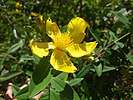 |
[76][38][35][36][87] |
| H. socotranum
R.D.Good |
Socotra St. John's Wort | Shrub |  |
[40] | |
| H. synstylum
N.Robson |
Shrub | Ethiopia, Somalia | [45][35] |
Sect. Concinna
Concinna N.Robson contains one species, H. concinnum, which is commonly known as Goldwire.
H. concinnum is a perennial herb or infrequently a subshrub that grows up to 45 centimeters tall. Its stems are erect or ascend from taproots and have dark glands, and change from 4-lined to 2-lined as the species grows. The leaves are placed opposite, and are decussate and free, with closed lamina. The species is 17-flowered and the flowers are stellate and homostylous, with five petals each. The species has five stamen fascicles and a total of 40-100 stamens.[6]
| Binomial | Common Name | Type | Distribution | Image | References |
|---|---|---|---|---|---|
| H. concinnum
Benth. (1849) |
Goldwire | Perennial herb/subshrub |  |
 |
[80][62][106][100][101] |
Sect. Coridium
Coridium Spach contains six species from with distributions across Europe. Its type species is H. coris.
The species in the section are low dwarf shrubs or perennial herbs that grow up to 60 centimeters tall. The leaves are glabrous or paperlike, with stems that branch from the taproot and that have dark red and black glands. The leaves are three or four-whorled and have one vein. The species have one to many flowers that come from one to six nodes and are stellate and homostylous. They have five sepals, five petals, and three stamen fascicles with a total of 25-60 stamens.[6]
| Binomial | Common Name | Type | Distribution | Image | References |
|---|---|---|---|---|---|
| H. amblyocalyx
Coustur. & Gand (1917) |
Dwarf shrub |  |
[45][21][18][13][70] | ||
| H. asperuloides
Czern. ex Turcz. (1858) |
Perennial herb | Russia |  |
[45] | |
| H. coris
L. (1753) |
Heath-leaved St. John's Wort | Low shrub | 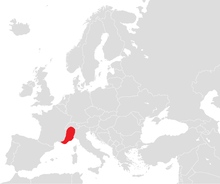 |
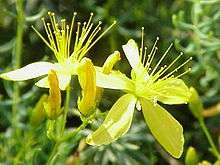 |
[75][76][13][66][90] |
| H. empetrifolium
Willd. (1803) |
Subshrub |  |
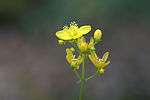 |
[14][66][28][60][70] | |
| H. ericoides
L. (1753) |
Dwarf shrub | Spain, Tunisia, Morocco | 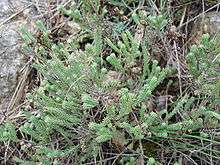 |
[51][21][13][14][19] | |
| H. jovis
Greuter (1975) |
Dwarf shrub | 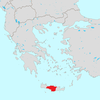 |
.jpg) |
[51][70] |
Sect. Crossophyllum
Crossophyllum Spach contains 4 species of perennial herbs. Its type species is H. orientale. The other species in the section are H. adenotrichum, H. aucheri, and H. thasium.
Species in Crossophyllum grow to be around 55 centimeters tall. They are glabrous, and their stems are erect from a rooting base. Their flowers also branch from the base and sometimes from intermediate nodes. The species have anywhere from 1 to 50 flowers which are stellate and homostylous. Their stems are narrow and eglandular and have dark black or amber glands on raised lines. The leaves are placed opposite and are free and decussate. The species have 5 sepals, 5 petals, and 3 or 5 stamen fascicles with 10-20 stamens each.[6]
| Binomial | Common Name | Type | Distribution | Image | References |
|---|---|---|---|---|---|
| H. adenotrichum
Spach (1826) |
Kantaron | Perennial herb | Turkey | .jpg) |
[50][18][33][23][31] |
| H. aucheri
Jaub. & Spach (1842) |
Perennial herb | Bulgaria, Greece, Turkey |  |
[50][21][18][13][23] | |
| H. orientale
L. (1753) |
Perennial herb | Georgia, Turkey, Russia |  |
[51][45][14][90][105] | |
| H. thasium
Griesb. (1843) |
Perennial herb | Bulgaria, Greece, Turkey |  |
[50][21][33][27][25] |
Sect. Drosocarpium
Drosocarpium Spach contains small perennial herbs that are found around the Mediterranean. H. richeri has 3 subspecies.
The species in the section grow up to 80 centimeters tall and are glabrous (except H. rochelii). Their leaves are placed opposite and are decussate and free. The species have anywhere between one and seventy flowers branching from one to three nodes which are stellate and homostylous. The species has five petals that are persistent after flowering and erect but not twisting, three or four stamen fascicles with a total of thirty to eighty stamens, and three to four styles.[6]
| Binomial | Common Name | Type | Distribution | Image | References |
|---|---|---|---|---|---|
| H. ambiguum
Elliott (1821) |
[8] | ||||
| H. barbatum
Jacq. (1775) |
Bearded St. John's Wort | Perennial herb | Austria, Italy, Balkans | [51][21][18][13][105] | |
| H. bithynicum
Boiss. (1849) |
Perennial herb | Georgia, Turkey (Northern) |  |
[21][18][13][27][19] | |
| H. confusum
Rose (1906) |
[21][18][33][34] | ||||
| H. montbretii
Spach (1836) |
Perennial herb | Balkans, Turkey, Syria, Lebanon, Russia |  |
[21][14][34][43][95] | |
| H. perfoliatum
L. (1767) |
Perennial herb | Iberia, North Africa, France, Italy, Greece, Turkey | [14][34][28][35][89] | ||
| H. richeri
Vill. (1779) |
Alpine St. John's Wort | Perennial herb | Balkans, Switzerland (Alps), Spain (Pyrenees) | [21][33][34][19][31] | |
| H. rochelii
Griseb. & Schenk (1852) |
Perennial herb | Balkans | [21][18] | ||
| H. rumeliacum
Boiss. (1849) |
Perennial herb | Balkans | [80][75][21][19][14] | ||
| H. spruneri
Boiss. (1849) |
Perennial herb | 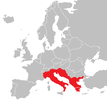 |
[21][33] | ||
| H. trichocaulon
Boiss. & Heldr. (1849) |
Perennial herb | 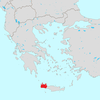 |
[21][33][14][70] | ||
| H. umbellatum
A. Kern. (1863) |
Perennial herb | Balkans | [21][33] | ||
| H. vesiculosum
Griesb. (1843) |
Perennial herb | Greece, Turkey | [21][33][14][25] |
Sect. Elodeoida
Elodeoida N.Robson contains tall species of annual and perennial herbs. Its type species is H. elodeoides.
The species in the section grow to be up to one meter tall. Their stems are erect or lie flat, sometimes branch out at the base, and are terete. The leaves have dark glands on them and are placed opposite, are decussate, and grow about a centimeter long. The species can have up to fifty flowers, which are homostylous and stellate. They have five petal that remain after flowering and are erect. There are five stamen fascicles are there are a total of nine to sixty stamens with dark anther glands. The seeds are cylindric.[6]
| Binomial | Common Name | Type | Distribution | Image | References |
|---|---|---|---|---|---|
| H. austroyunnanicum
L.H. Wu & D.P. Yang (2002) |
Minnan St. John's Wort | Perennial herb |  |
[50][73][7] | |
| H. elodeoides
Choisy (1824) |
Straight-stemmed St. John's Wort | Perennial herb | China, Myanmar, India, Bhutan, Nepal |  |
[50][63][73][7] |
| H. hubeiense
L.H. Wu & D.P. Yang (2004) |
Perennial herb |  |
[50][73] | ||
| H. kingdonii
N.Robson (2001) |
Perennial herb | China, Myanmar, India | [50][73][7] | ||
| H. petiolulatum
Hook.f. & Thomson ex Dyer (1874) |
Perennial herb/annual herb | China, India, Southeast Asia | [50][73][86] | ||
| H. qinlingense
X.C.Du & Y.Ren (2005) |
Perennial herb | 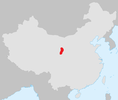 |
[50][73][107] | ||
| H. seniawinii
Maxim. (1881) |
Perennial herb | 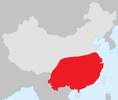 |
[50][34][73][7] |
Sect. Graveolentia
Graveolentia N.Robson is a diverse section of nine species whose type species is H. graveolens.
Graveolentia is similar to sect. Hypericum but differs in having mature stem internodes with different characteristics, as well as sepals with linear laminar glands and amber anther glands. Species in the section have one to seventy flowers regularly, but can have up to 124 in some circumstances, and they grow from one to four different nodes. The species have five sepals that are free and persistent and stand erect when the plants are in fruit. They also have five petals that are erect and not twisting and lack apiculus. There are also five stamen fascicles with a total of sixteen to ninety stamens.[6]
| Binomial | Common Name | Type | Distribution | Image | References |
|---|---|---|---|---|---|
| H. collinum
Schltdl. & Cham. (1830) |
Wiry perennial herb | Mexico | [8][23] | ||
| H. epigeium
R.Keller (1908) |
Wiry perennial herb | Mexico, Guatemala | [8][2] | ||
| H. formosum
Kunth (1822) |
Western St. John's Wort | Perennial herb | Mexico | _in_Logan_Pass_-_Flickr_-_Jay_Sturner.jpg) |
[76][106][43] |
| H. graveolens
Buckley (1843) |
Mountain St. John's Wort | Perennial herb |  |
 |
[80][75][100][101] |
| H. macvaughii
N.Robson (2006) |
Perennial herb | Mexico | [51][34] | ||
| H. oaxacanum
R.Keller (1923) |
Wiry perennial herb/subshrub | Guatemala, Mexico | [45][34] | ||
| H. pringlei
S.Watson (1890) |
Perennial herb | Mexico | [45][2] | ||
| H. pseudomaculatum
Bush (1901) |
False Spotted St. John's Wort | Perennial herb |  |
[80][75][99][100][101] | |
| H. punctatum
Lam. (1796) |
Spotted St. John's Wort | Perennial herb | Canada, United States | .jpg) |
[103][108][104][100][34] |
Sect. Heterophylla
Heterophylla N.Robson contains a single shrublet, H. heterophyllum, from which the section derives its name.
H. heterophyllum is a shrublet that grows to be up to 25 centimeters tall. It is semi-deciduous and glabrous and lacks dark glands. The stems are 2-lined and are colored cortex green, but their bark is smooth and reddish brown. The leaves are placed opposite and are decussate, sessile, and free. The leaf blades are open or 1-nerved and their glands are linear to punctiform and are dense in the margins but the ventral glands are absent. They have 3-12 flowers that branch from 1-3 nodes and sometimes the lower branches will flower as well., and the flowers are stellate and homostylous. There are five sepals, three styles, and three stamen fascicles with a total of 35-45 stamens.[6]
| Binomial | Common Name | Type | Distribution | Image | References |
|---|---|---|---|---|---|
| H. heterophyllum
Vent. (1802) |
Shrublet |  |
_(9340619637).jpg) |
[51][45][27][43][105] |
Sect. Hirtella
Hirtella Stef., not to be confused with the unrelated genus Hirtella described by Linneaus, is split into two subsections: subsect. Platyadenum and subsect. Stenadum, which have eighteen and eleven species respectively for a total of twenty nine species.
The section contains perennial herbs that grow up to eighty centimeters tall. They are often glaucous and the stems are erect or decumbent, and are rarely rooting (H. hyssopifolium). The stems are 2-lined and usually glandiferous. The leaves are placed opposite, are decussate, sessile, and are usually free. The leaf blades have pale glands but lack ventral glands. The species have few to many flowers that grow from five to fifteen nodes, and sometimes have flowering branches from lower nodes. Their flowers are stellate and homostylous. They have five sepals, five petals that are sometimes tinged red, and around three stamen fascicles with a total of 25-60 stamens. The seeds are cylindical in shape.[6]
| Binomial | Common Name | Type | Distribution | Image | References |
|---|---|---|---|---|---|
| Subsection Platyadenum | |||||
| H. amblysepalum
Hochst. (1845) |
Perennial herb | Israel, Lebanon, Syria, Turkey, Iraq, Iran | [50][18][33][27][29] | ||
| H. asperulum
Jaub. & Spach (1842) |
Perennial herb | Iraq | .jpg) |
[22][23] | |
| H. capitatum
Choisy (1821) |
Perennial herb | Syria, Turkey | [18][27][23][25] | ||
| H. hedgei
N.Robson (2010) |
Perennial herb |  |
[25] | ||
| H. helianthemoides
(Spach) Boiss. (1849) |
Perennial herb | Turkey, Azerbaijan, Iran, Turkmenistan | [2][27] | ||
| H. hirtellum
(Spach) Boiss. (1849) |
Perennial herb | Iran, Iraq | [26] | ||
| H. libanoticum
N.Robson (1970) |
Perennial herb |  |
 |
[45][29] | |
| H. lydium
Boiss. |
Perennial herb | .jpg) |
[51][33][27][25] | ||
| H. lysimachioides
Boiss. & Noë (1854) |
Perennial herb | Turkey, Iraq, Iran | [33][27][25] | ||
| H. olivieri
(Spach) Boiss. (1867) |
Perennial herb | Jordan, Syria, Turkey, Iraq, Iran? | .jpg) |
[33][27][25] | |
| H. pseudolaeve
N.Robson (1967) |
Perennial herb | Turkey, Georgia, Armenia, Azerbaijan | [18][27][25] | ||
| H. retusum
Aucher ex Jaub. & Spach (1842) |
Perennial herb | Syria, Turkey, Iraq | .jpg) |
[8][18][33][27][25] | |
| H. scabroides
N.Robson & Poulter (1967) |
Perennial herb | Turkey | [22][33][27][25] | ||
| H. scabrum
L. (1755) |
Perennial herb | Middle East, Caucasus, Central Asia, China |  |
[109][33][14][34][29] | |
| H. spectabile
Jaub. & Spach (1842) |
Perennial herb | Turkey, Syria | [33][27][43][25] | ||
| H. thymbrifolium
Boiss. & Noë (1854) |
Perennial herb | Turkey | [33][27][25] | ||
| H. thymopsis
Boiss. (1854) |
Perennial herb | Turkey | [33][27][25] | ||
| H. vermiculare
Boiss. & Hausskn. (1888) |
Perennial herb | Iraq, Iran | .jpg) |
[26] | |
| Subsection Stenadenum | |||||
| H. apiculatum
(N.Robson) Sennikov (1993) |
Perennial herb | Turkey, Transcaucasia, Iran, Central Asia | [2][25] | ||
| H. apricum
Kar. & Kir. (1842) |
Perennial herb | Central Asia | [45][18][33][27] | ||
| H. callithyrsum
Coss. (1852) |
Perennial herb | Spain, Morocco | [13][35] | ||
| H. davisii
N.Robson |
Perennial herb | Turkey, Armenia, Iran | [22][18][33][27][25] | ||
| H. elongatum
Ledeb. ex Rchb. (1825) |
Perennial herb | Turkey, Transcaucasia, Iran, Central Asia, China | [18][33][27][35][73] | ||
| H. hyssopifolium
Chaix (1786) |
Perennial herb | Spain, France, Italy, Serbia, Bulgaria |  |
[21][13][14][19][35] | |
| H. karjaginii
Rzazade (1954) |
Perennial herb | Turkey, Armenia, Azerbaijan, Iran | [2][25] | ||
| H. microcalycinum
Boiss. & Heldr. (1849) |
Perennial herb | Turkey (Antalya, Konya, Isparta, Adana, Hatay) | [25] | ||
| H. salsolifolium
Hand.-Mazz. (1913) |
Perennial herb | Turkey | .jpg) |
[26][33][27][25] | |
| H. sorgerae
N.Robson (1986) |
Perennial herb | Turkey | [22][18][33][27][25] | ||
| H. tymphresteum
Boiss. & Spruner (1843) |
Perennial herb | 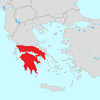 |
[2] | ||
Sect. Humifusoideum
Humifusoideum R. Keller, also called Pulogensia, contains 6 species. Its type species is H. peplidifolium. H. beccarii has two subspecies: H. beccarii beccarii and H. beccarii steenisii.
Sect. Humifusoideum contains shrubs, subshrubs, and herbs that grow erect or prostrate and grow up to 1.5 meters tall. The shrubs are evergreen and glabrous and usually have dark glands. The stems are either 2-lined or 4-lined and are flattened when the plant is young, they usually lack glands, but rarely have dark glands; they are colored cortex greed or a dark red, while the bark is smooth and colored red-brown. The leaves are placed opposite, are decussate and free, and their blades are entire and either closed or open, with pale glands. The species usually have one flower, but very rarely can have up to ten that come from two nodes. The flowers are stellate and homostylous and have five free sepals that are persistent, five petals that are persistent and spreading, and three to five stamen fascicles with anywhere from ten to eighty stamens. The seeds are cylindric.[6]
| Binomial | Common Name | Type | Distribution | Image | References |
|---|---|---|---|---|---|
| H. beccarii
N.Robson (1973) |
Beccari's St. John's Wort | Perennial/annual herb | Indonesia (Sumatra, Java) | [45][2][23][43][86] | |
| H. nagasawae
Hayata (1973) |
Perennial herb/shrublet |  |
[110][43][73][7] | ||
| H. natalense
J.M. Wood & M.S. Evans |
Perennial herb | South Africa, Swaziland | [45][34][35] | ||
| H. nokoense
Ohwi (1937) |
Perennial herb |  |
[73][7] | ||
| H. peplidifolium
A.Rich (1847) |
Perennial herb | Sub-saharan Africa | [36][38][41][39][87] | ||
| H. wilmsii
R.Keller (1908) |
Perennial herb | Zimbabwe, South Africa, Madagascar | [45][35][38][95] |
Sect. Hypericum
Hypericum, sometimes referred to as the "type section" of the genus, contains perennial herbs and very few subshrubs. It contains the type species of the genus, H. perforatum. Subsect. Erecta, with twenty-three species, is the far less studied subsection of the section, while the details of subsect. Hypericum have been much more analyzed. Subsect. Hypericum has eighteen species total, with ten (including the type species) in ser. Hypericum, and eight in ser. Senanensia. The section contains forty-one species in total.
The species in sect. Hypericum grow to be 1.2 meters tall and can grow either erect or prostrate. They are glabrous some have dark glands while others do not. Their stems are 2-lined or 2-winged when young and either remain so or become terete as the plant ages. The leaves are placed opposite or abnormally whorled, are decussate, and are either sessile or pseudopetiolate, as well as being free and persistent. They are up to 70-flowered from one to four nodes, with some lower subsidiary branches. The flowers are stellate and homostylous. The species have 5 persistent sepals, 3 stamen fascicles, and 20-100 total stamens.[6]
| Binomial | Common Name | Type | Distribution | Image | References |
|---|---|---|---|---|---|
| Subsection Erecta | |||||
| H. asahinae
Makino |
Perennial herb | Japan | [8] | ||
| H. elegans
Stephan ex Willd. |
Elegant St. John's Wort | Perennial herb | Russia, Germany, Eastern Europe, Balkans | 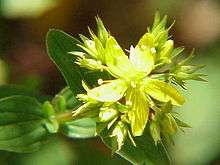 |
[26][18][13][14][27] |
| H. erectum
Thunb. |
Perennial herb | Russia, Korea, Japan, Taiwan, China | [80][14][78][19][31] | ||
| H. furusei
N.Robson |
Perennial herb | Japan | [45] | ||
| H. gracillimum
Koidz. |
Perennial herb | Japan | [22] | ||
| H. hachijyoense
Nakai |
Perennial herb | Japan (Honshū) | [2] | ||
| H. hakonense
Franch. & Sav. |
Perennial herb | Japan | [15][19] | ||
| H. kawaranum
N.Robson |
Perennial herb | Japan (Hokkaidō) | [8] | ||
| H. kinashianum
Koidz. |
Perennial herb | Japan (Honshū, Kyūshū) | [22] | ||
| H. kitamense
(Y.Kimura) N.Robson |
Perennial herb | Japan (Hokkaidō) | |||
| H. kiusianum
Koidz. |
Perennial herb | Japan (Honshū, Kyūshū, Ryūkyū Islands) | [2][19] | ||
| H. kurodakeanum
N.Robson |
Perennial herb | Japan | |||
| H. nikkoense
Makino |
Perennial herb | Japan | |||
| H. nuporoense
N.Robson |
Perennial herb | Japan (Hokkaidō) | [2] | ||
| H. ovalifolium
Koidz. |
Perennial herb | Japan | |||
| H. pseudoerectum
N.Robson |
Perennial herb | Japan (Hokkaidō) | [26] | ||
| H. pseudopetiolatum
R.Keller |
Perennial herb | Japan | [111][112][14][86][7] | ||
| H. taihezanense
Sasaki ex S.Suzuki |
Perennial herb | Taiwan, China, Philippines, Malaysia, Indonesia | [73][7] | ||
| H. uniglandulosum
Hausskn. ex Bornm. |
Perennial herb | [22][18][33][27] | |||
| H. vulcanicum
Koidz. |
Perennial herb | Japan | [8] | ||
| H. watanabei
N.Robson |
Perennial herb | Japan | |||
| H. yamamotoanum
H.Koidz. |
Perennial herb | Japan (Hokkaidō) | [2] | ||
| H. yamamotoi
Miyabe & Kimura |
Perennial herb | Japan (Hokkaidō) | [45] | ||
| Subsection Hypericum | |||||
| Series Hypericum | |||||
| H. attenuatum
Fisch. ex Choisy (1821) |
Perennial herb | Russia, China, Mongolia, Korea | [34][78][15][31][73] | ||
| H. iwate-littorale
H.Koidz. (1937) |
Perennial herb | Japan (Honshû, Iwate) | [26][2] | ||
| H. maculatum
Crantz (1763) |
Imperforate St. John's Wort | Perennial herb | Europe, Canada (Introduced) |  |
[75][76][81][30][60] |
| H. momoseanum
Makino (1931) |
Perennial herb | Japan (Honshû) | [8] | ||
| H. perforatum
L. (1753) |
Common St. John's Wort
Perforate St. John's Wort Klamath weed |
Perennial herb |  |
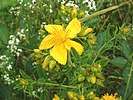 |
[108][79][113][114][115] |
| H. scouleri
Hook. (1831) |
Scouler's St. John's Wort | Perennial herb | Canada, United States, Mexico |  |
[80][62][100][46] |
| H. tetrapterum
Fr. (1828) |
Slender St. John's Wort | Perennial herb |  |
 |
[76][116][113][81][60] |
| H. triquetrifolium
Turra (1765) |
Wavy-leaved St. John's Wort
Curled-leaved St. John's Wort |
Perennial herb |  |
 |
[47][28][29][77][70] |
| H. undulatum
Schousb. ex Willd. (1809) |
Flax-Leaved St. John's Wort | Perennial herb | British Isles, France (Brittany), Iberia, North Africa | 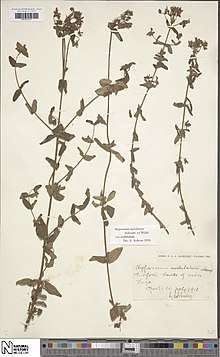 |
[116][33][81][60][31] |
| H. yezoënse
Maxim. (1887) |
Perennial herb | 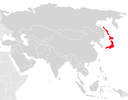 |
[50] | ||
| Series Senanensia | |||||
| H. enshiense
L.H. Wu & F.S. Wang (2004) |
Perennial herb | China (Hubei) | [73][7] | ||
| H. faberi
R.Keller (1925) |
Perennial herb | China | [73][7] | ||
| H. kamtschaticum
Ledeb. (1841) |
Perennial herb | Russia, Japan | 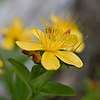 |
[45][14][78][15][19] | |
| H. nakaii
H.Koidz. (1937) |
Perennial herb | Japan (Hokkaido) | [8] | ||
| H. oliganthum
Franch. & Sav. (1878) |
Perennial herb | Korea, Japan | [22] | ||
| H. pibairense
(Miyabe & Y.Kimura) N.Robson (2006) |
Perennial herb | Japan (Hokkaido) | [2] | ||
| H. senanense
Maxim. (1887) |
Perennial herb | [2] | |||
| H. sikokumontanum
Makino (1898) |
Perennial herb | Japan (Shikoku, Kyūshū) | [19] | ||
Sect. Inodora
Inodora Stef. contains one species, a shrub called H. xylosteifolium or sometimes H. inodorum.
H. xylosteifolium grows to be approximately 1.5 meters, and is a deciduous plant. It typically has anywhere from 1-7 flowers, which are terminal and sometimes have subsidiary branches. The flowers are 1.5–3 cm in diameter and are stellate and rounded. Its anthers are yellow-orange and its stamen are in fascicles in groups of 10-11.[6]
| Binomial | Common Name | Type | Distribution | Image | References |
|---|---|---|---|---|---|
| H. xylosteifolium
(Spach) N.Robson (1967) |
Turkish Tutsan | Shrub | 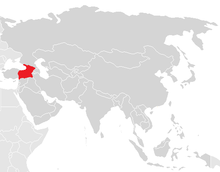 |
 |
[51][45][66][81][105] |
Sect. Monanthema
Monanthema N.Robson contains 7 species native to eastern Asia. One of its species, H. monanthemum, has two subspecies: H. monanthemum filicaule and H. monanthemum monanthemum.
The section contains small perennial herbs that grow up to 40 centimeters tall. Their stems are erect to prostrate, and are creeping and branching at the base of the plant. They are glabrous and have dark glands on their leaves, seals, and petals. The stems are terete when mature and are normally eglandular, but will very rarely have a few reddish glands. The leaves are opposite, decussate, and sessile or pseudopetiolate. The laminar glands are either pale or black, and can be very dense to almost absent, and are relatively small. The species are normally 1-15 flowered, but in rare cases can have up to 50 flowers. They grow from one or two nodes, with lower subsidiary branches, and are stellate and homostylous. They have five sepals, five petals, five stamen fascicles with 10-45 total stamens, and 2-4 ovaries. The seeds are cylindric and not carinate.[6]
| Binomial | Common Name | Type | Distribution | Image | References |
|---|---|---|---|---|---|
| H. daliense
N.Robson (2001) |
Perennial herb |  |
[50][73][7] | ||
| H. himalaicum
N.Robson (1977) |
Perennial herb | 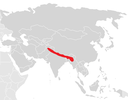 |
[50][63][73][7] | ||
| H. ludlowii
N.Robson (1983) |
Perennial herb |  |
[50][63][73][7] | ||
| H. monanthemum
Hook.f. & Thomson ex Dyer (1874) |
Perennial herb | 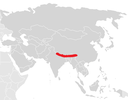 |
[50][14][73][7] | ||
| H. subcordatum
(R.Keller) N.Robson (2001) |
Perennial herb |  |
[50][73][7][26] | ||
| H. trigonum
Hand.-Mazz. (1931) |
Perennial herb |  |
[50][73][7] | ||
| H. wightianum
Wall. ex Wight & Arn. (1834) |
Perennial herb |  |
[50][63][43][73][7] |
Sect. Myriandra
Myriandra (Spach) R. Keller contains shrubs, shrublets, and perennial herbs that grow to be up to 4.5 m.
| Binomial | Common Name | Type | Distribution | Image | References |
|---|---|---|---|---|---|
| Subsection Ascyrum | |||||
| H. crux-andreae
(L.) Crantz |
Atlantic St. Peter's Wort | Shrub | 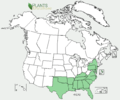 |
 |
[99][117][118][100][101] |
| H. edisonianum
(Small) W.P. Adams & N.Robson |
Arcadian St. John's Wort | Shrub | United States | [80][75][99][100][101] | |
| H. hypericoides
(L.) Crantz |
St. Andrew's Cross | Shrub/Wiry shrublet | USA, Mexico, Central America | _(6757577093).jpg) |
[99][117][118][100][101] |
| H. suffruticosum
W.P. Adams & N.Robson |
Pineland St. John's Wort | Dwarf shrub | United States | [80][76][99][118][100] | |
| H. tetrapetalum
Lam. |
Four-Petaled St. John's Wort | Shrub/Perennial herb | United States, Cuba | [80][75][76][99][100] | |
| Subsection Brathydium | |||||
| H. dolabriforme
Vent. |
Straggling St. John's Wort | Subshrub | United States | [75][104][76][100][101] | |
| H. myrtifolium
Lam. |
Myrtle-leaf St. John's Wort | Shrub | United States | [75][76][99][100][101] | |
| Subsection Centrosperma | |||||
| H. brachyphyllum
(Spach) Steud. |
Coastal Plain St. John's Wort | Shrub | United States | [80][76][99][100][101] | |
| H. chamaenerium
(Spach) Steud. |
Roundfruit St. John's Wort | [50][2] | |||
| H. chapmanii
W.P. Adams |
Apalachicola St. John's Wort | Shrub | United States (Florida) | [80][75][76][101][119] | |
| H. densiflorum
Pursh |
Dense St. John's Wort | Shrub | Eastern United States | [104][118][63][100][101] | |
| H. exile
W.P. Adams |
Florida Sands St. John's Wort | Southeastern United States | [80][75][99][101] | ||
| H. fasciculatum
Lam. |
Peelbark St. John's Wort
Sandweed |
Shrub | United States | [80][99][118][100][101] | |
| H. frondosum
Michx. |
Cedarglade St. John's Wort | Shrub | United States |  |
[104][99][100][101][66] |
| H. galioides
Lam. |
Bedstraw St. John's Wort | Shrub | United States | [99][117][118][101][66] | |
| H. glomeratum
Small |
[22][34] | ||||
| H. kalmianum
L. |
Kalm's St. John's Wort | Shrublet | United States, Canada |  |
[103][108][100][31][120] |
| H. lissophloeus
W.P. Adams |
Smoothbark St. John's Wort | Shrub | United States | [75][76][99][101][85] | |
| H. lloydii
(Svenson) P.B.Adams |
Sandhill St. John's Wort | Shrub | United States | [80][75][118][100][101] | |
| H. lobocarpum
Gatt. |
Fivelobe St. John's Wort | Shrub | United States |  |
[80][75][76][101][119] |
| H. nitidum
Lam. |
Carolina St. John's Wort | Shrub/small tree | United States, Cuba, Belize | [76][99][118][101][119] | |
| H. opacum
Torr. & A. Gray |
[51][34] | ||||
| H. prolificum
L. |
Shrubby St. John's Wort | Shrub | United States, Canada |  |
[104][99][118][100][85] |
| H. swinkianum
G.Wilh. & L. Rericha |
Swink's St. Johns wort | Shrub |  |
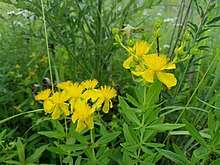 |
[121][103][34][122] |
| H. tenuifolium
Pursh |
Atlantic St. John's Wort | Shrub |  |
 |
[118][22][34][119][98] |
| Subsection Pseudobrathydium | |||||
| H. buckleyi
M.A.Curtis |
Buckley's St. John's Wort | Shrub |  |
[118][100][101][34][66] | |
| Subsection Suturosperma | |||||
| H. adpressum
W.P.C. Barton |
Creeping St. John's Wort | Perennial herb |  |
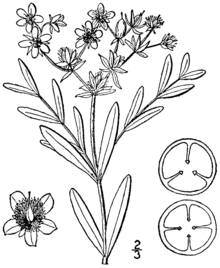 |
[103][104][76][100][101] |
| H. apocynifolium
Small |
Early St. John's Wort | Shrub |  |
[76][99][101][34][119] | |
| H. cistifolium
Lam. |
Roundpod St. John's Wort | Shrub/subshrub |  |
.gif) |
[99][118][63][100][101] |
| H. ellipticum
Hook. |
Pale St. John's Wort | Perennial herb | Canada, United States | [103][108][104][100][123] | |
| H. microsepalum
(Torr. & A. Gray) A. Gray ex S. Watson |
Flatwoods St. John's Wort | Shrub |  |
[75][76][99][100][101] | |
| H. nudiflorum
Michx. ex Willd. |
Early St. John's Wort | Shrub |  |
[75][99][118][100][101] | |
| H. sphaerocarpum
Michx. |
Roundseed St. John's Wort | Subshrub/perennial herb |  |
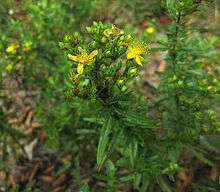 |
[85][76][100][102][120] |
Sect. Oligostema
Oligostema (Boiss.) Stef. consists of perennial and annual herbs up to 75 cm tall.
| Binomial | Common Name | Type | Distribution | Image | References |
|---|---|---|---|---|---|
| H. andjerinum
Font Quer & Pau |
Perennial herb | Morocco | [26][22][18][35][23] | ||
| H. australe
Ten. |
Perennial herb |  |
[21][124][18][13][47] | ||
| H. humifusum
L. |
Trailing St. John's Wort | Perennial/ biennial/annual herb | 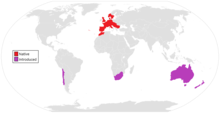 |
 |
[125][63][101][81][31] |
| H. kelleri
Bald. |
Keller's St. John's Wort | Perennial herb |  |
[80][21][19][70] | |
| H. linariifolium
Vahl |
Toadflax-leaved St. John's Wort | Perennial herb |  |
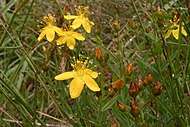 |
[21][2][81][15][19] |
| H. repens
L. |
Perennial herb |  |
 |
[26][33][28][15][35] |
Sect. Olympia
Olympia (Spach) Nymam contains four dwarf shrubs. Its type species is H. olympicum.
| Binomial | Common Name | Type | Distribution | Image | References |
|---|---|---|---|---|---|
| H. auriculatum
(N.Robson & Hub.-Mor.) N.Robson (2010) |
Shrub/subshrub |  |
[51][22][95][25] | ||
| H. lycium
(N.Robson & Hub.-Mor.) N.Robson (2010) |
Shrub/subshrub |  |
[51][2][126][25] | ||
| H. olympicum
L. (1753) |
Mount Olympus St. John's Wort | Shrub/subshrub | Balkans |  |
[51][63][77][90][105] |
| H. polyphyllum
Boiss. & Balansa (1856) |
Shrub/subshrub | Southeastern Turkey, Syria |  |
[80][51][27][15][19] |
Sect. Origanifolia
Origanifolia Spach contains 13 species of shrub-like perennial herbs. Its type species is H. origanifolium.
| Binomial | Common Name | Type | Distribution | Image | References |
|---|---|---|---|---|---|
| H. albiflorum
(Hub.-Mor.) N.Robson |
Perennial herb | Turkey | [50][25] | ||
| H. aviculariifolium
Jaub. & Spach |
Perennial herb | Turkey | [21][18][13][27][90] | ||
| H. bourgaei
(Boiss.) N.Robson |
Perennial herb | Turkey | [50][25] | ||
| H. cymbiferum
Boiss. & Balansa |
Perennial herb | Turkey | [50][25] | ||
| H. ichelense
N.Robson |
Perennial herb | Turkey | [50][25] | ||
| H. imbricatum
Poulter |
Perennial herb | Turkey | [50][33][27][25] | ||
| H. laxiflorum
N.Robson |
Perennial herb | Turkey | [50][25] | ||
| H. leprosum
Boiss. |
Perennial herb | Turkey | [50][25] | ||
| H. origanifolium
Willd. |
Perennial herb | Georgia, Syria, Turkey |  |
[50][22][27][15][105] | |
| H. papillare
Boiss. & Heldr. |
Perennial herb | Turkey | [50][25] | ||
| H. salsugineum
N.Robson & Hub.-Mor. |
Perennial herb | Turkey | [50][18][33][27][25] | ||
| H. trachyphyllum
Griseb. |
Perennial herb | Turkey | [50][22][25] | ||
| H. uniflorum
Boiss. & Heldr. |
Perennial herb | Turkey | [50][25] |
Sect. Psorophytum
Psorophytum (Spach) Nyman contains a single species, H. balearicum.
| Binomial | Common Name | Type | Distribution | Image | References |
|---|---|---|---|---|---|
| H. balearicum
L. (1753) |
Hipérico de las Baleares | Shrub/small tree | 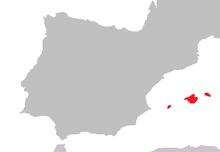 |
 |
[40][127][18][105] |
Sect. Roscyna
Roscyna (Spach) R. Keller contains 2 species: its type species, H. ascyron, and H. przewalskii. Roscyna was once considered to be its own individual genus which contained only the two species. H. ascyron has two subspecies, H. ascyron ascyron and H. ascyron gebleri.
| Binomial | Common Name | Type | Distribution | Image | References |
|---|---|---|---|---|---|
| H. ascyron
L. (1753) |
Great St. John's Wort | Perennial herb | [103][104][108][100][120] | ||
| H. przewalskii
Maxim. (1881) |
Przewalksi's St. John's Wort | Perennial herb |  |
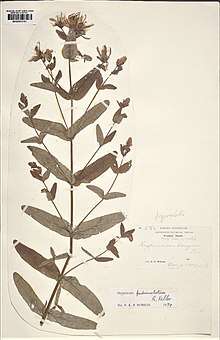 |
[51][34][43][73] |
Sect. Sampsonia
Sampsonia N.Robson contains two species: its type species, H. sampsonii, and H. assamicum.
| Binomial | Common Name | Type | Distribution | Image | References |
|---|---|---|---|---|---|
| H. assamicum
S.N.Biswas (1971) |
Assamese St. John's Wort | Perennial herb | India | [51][128][63] | |
| H. sampsonii
Hance (1865) |
Sampson's St. John's Wort | Perennial herb | China, Japan, Southeast Asia |  |
[34][78][129][46] |
Sect. Santomasia
Santomasia (N.Robson) N.Robson contains a single species, H. steyermarkii.
| Binomial | Common Name | Type | Distribution | Image | References |
|---|---|---|---|---|---|
| H. steyermarkii
Standl. (1940) |
Unknown | Guatemala, Mexico | [8][22] |
Sect. Taeniocarpium
Taeniocarpium Jaub. & Spach contains small wiry perennial herbs up to 1.1 meters tall.
| Binomial | Common Name | Type | Distribution | Image | References |
|---|---|---|---|---|---|
| H. armenum
Jaub. & Spach |
Perennial herb | Eastern Turkey, Armenia | [26][22][18][14][23] | ||
| H. confertum
Choisy |
Perennial herb | Turkey to Lebanon, Cyprus | [28][15][19][23][25] | ||
| H. crenulatum
Boiss. |
Dwarf shrub | Central Anatolia | [50][18][33][23][25] | ||
| H. fissurale
Woronow |
Cracked St. John's Wort | Perennial herb | Turkey | [40][18][27][24][25] | |
| H. havvae
Güner |
Perennial herb | Turkey | [8][27][25] | ||
| H. hirsutum
L. |
Hairy St. John's Wort | Perennial herb |  |
 |
[13][113][130][81][30] |
| H. kotschyanum
Boiss. |
Perennial herb | Turkey |  |
[22][18][33][14][19] | |
| H. linarioides
Bosse |
Perennial herb | Caucasia, Middle East, Turkey, Russia, Balkans | [21][27][15][19][105] | ||
| H. malatyanum
Peșmen |
Perennial herb | Turkey | [18][33][27][25] | ||
| H. marginatum
Woronow |
Perennial herb | Turkey | [22][18][25] | ||
| H. monadenum
N.Robson |
Perennial herb | Southern Turkey | [33][34][27][25] | ||
| H. neurocalycinum
Boiss. & Heldr. |
Perennial herb | Central Turkey | [18][27][25] | ||
| H. nummularioides
Trautv. |
Perennial herb | Russia, Georgia, Turkey | [18][33][27][25] | ||
| H. nummularium
L. |
Perennial herb | France, Spain, Italy (Extinct) | .jpg) |
[21][33][19][89][43] | |
| H. peshmenii
Yıld. |
Perennial herb | Turkey | [8][27][25] | ||
| H. pruinatum
Boiss. & Balansa |
Shrublet/ Perennial herb | Turkey, Georgia | [22][18][33][27][15] | ||
| H. pseudorepens
N.Robson |
Perennial herb | Turkey | [2][25] | ||
| H. pulchrum
L. |
Slender St. John's Wort | Perennial herb |  |
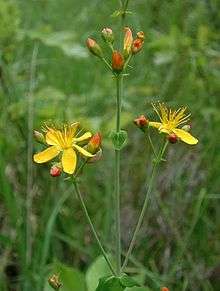 |
[80][75][76][14][81] |
| H. pumilio
Bornm. |
Shrublet | Turkey | [8][22][18][25] | ||
| H. saxifragum
N.Robson & Hub.-Mor. |
Perennial herb | Turkey | [26][18][33][27][25] | ||
| H. taygeteum
Quézel & Contandr. |
Perennial herb | Greece | [21][18][33][19] | ||
| H. theodori
Woronow |
Theodor's St. John's Wort | Perennial herb | Azerbaijan | [40] | |
| H. thymifolium
Banks & Sol. |
Subshrub | Turkey, Syria, Lebanon, Israel | [33][27][29][25] | ||
| H. vaccinioides
N.Robson |
Dwarf shrub | Turkey | [45][33][25] | ||
| H. venustum
Fenzl |
Perennial herb | Lebanon, Turkey, Georgia, Armenia, Azerbaijan | [26][18][27][25] |
Sect. Takasagoya
Takasagoya (Y.Kimura) N.Robson contains deciduous shrubs and shrublets that grow up to 1.5 m tall.
| Binomial | Common Name | Type | Distribution | Image | References |
|---|---|---|---|---|---|
| H. formosanum
Maxim. (1881) |
Taiwanese St. John's Wort | Shrub |  |
[75][51][73][7] | |
| H. geminiflorum
Hemsl. (1895) |
Shrub | Taiwan, Philippines | [43][73][86][7] | ||
| H. nakamurai
(Masam.) N.Robson (1973) |
Shrub |  |
[73][7] | ||
| H. senkakuinsulare
Hatus. (1973) |
Shrub | Ryukyu Islands | [51][22] | ||
| H. subalatum
Hayata (1911) |
Shrub |  |
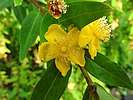 |
[73][110][7] |
Sect. Triadenioides
Triadenioides Jaub. & Spach contains 7 species. Its type species is H. pallens. H. haplophylloides has two subspecies: H. haplophylloides haplophylloides and H. haplophylloides devollense. The species of the section are found in the mountain ranges of Turkey and the Levant, and several are confined to the island of Socotra.[105]
Triadenioides contains shrubs and shrublets that grow up to 60 centimeters tall. They grow prostrate to erect and the lower parts of the plant are deciduous. Those confined to Socotra lack dark glands, but the species in the Levant have red to black glands on the flower and sometimes leaves or stems.[105] The leaves are either opposite or 3-whorled and are free and either sessile or petiolate. The species have between one and thirteen flowers that are stellate and have one style. They have 5 petals each which are spreading or erect. They have 3 stamen fascicles with many stamens and have 5 sepals.[6]
| Binomial | Common Name | Type | Distribution | Image | References |
|---|---|---|---|---|---|
| H. fieriense
N.Robson (1993) |
Shrub |  |
[40][2] | ||
| H. haplophylloides
Halácsy & Bald. (1893) |
[51][21][131][13][19] | ||||
| H. musadoganii
Yıld. (2010) |
[51][22] | ||||
| H. pallens
Banks & Solander |
Shrublet | Turkey, Syria, Lebanon | 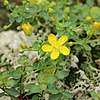 |
[51][14][27][19][25] | |
| H. scopulorum
Balf.f (1882) |
Shrub |  |
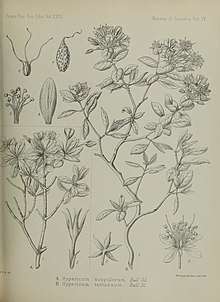 |
[40][43][95] | |
| H. ternatum
Poulter (1954) |
Shrublet | Turkey | [45][33][27][25] | ||
| H. tortuosum
Balf.f (1882) |
Shrub/Shrublet |  |
 |
[40][43] |
Sect. Trigynobrathys
Trigynobrathys (Y. Kimura) N.Robson contains shrubs and subshrubs as well as annual and perennial herbs that are very diverse in size and shape.
| Binomial | Common Name | Type | Distribution | Image | References |
|---|---|---|---|---|---|
| Subsection Connatum | |||||
| H. brasiliense
Choisy |
Subshrub/annual herb? | Brazil, Paraguay, Bolivia, Argentina | [26][34][15][43][93] | ||
| H. caespitosum
Cham. & Schltdl. |
Perennial/annual herb | 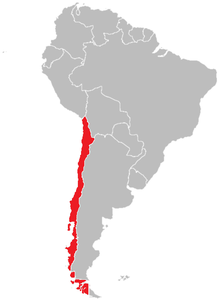 |
[8][23] | ||
| H. campestre
Cham. & Schltdl. |
Subshrub | Brazil, Paraguay, Argentina, Uruguay | [45][23][93] | ||
| H. caprifoliatum
Cham. & Schltdl. |
Subshrub | Brazil, Argentina | [22][34][15][23] | ||
| H. carinatum
Griseb. |
Subshrub/annual herb | Brazil, Paraguay, Argentina, Uruguay | [2][15][23] | ||
| H. cavernicola
L.B. Sm. |
Subshrub | Uruguay | [2][23] | ||
| H. connatum
Lam. |
Subshrub/perennial herb | Brazil, Uruguay, Argentina, Parguay, Bolivia | [22][92][23][93][132] | ||
| H. cordatum
(Vell.) N.Robson |
Subshrub/perennial herb | Brazil | [26][2][23][43] | ||
| H. cumulicola
(Small) P.B. Adams |
Highlands Scrub St. John's Wort | Perennial herb | United States (Florida) |  |
[80][99][101][133][134] |
| H. denticulatum
Walter |
Coppery St. John's Wort | Perennial herb | United States |  |
[75][99][14][100][101] |
| H. denudatum
A. St.-Hil. |
Shrub/subshrub | Brazil, Argentina | |||
| H. erythreae
(Spach) Steud. |
Sparse-leaved St. John's Wort | Perennial herb | United States | [75][101][34][119] | |
| H. gramineum
G.Forst. |
Grassy St. John's Wort | Perennial/annual herb | Oceania, Vietnam, China, India, Hawaii | .jpg) |
[76][63][101][61][46] |
| H. harperi
R.Keller |
Sharplobe St. John's Wort | Perennial herb | United States | [80][75][76][99][101] | |
| H. legrandii
L.B. Sm. |
Subshrub | Uruguay | [22][43] | ||
| H. linoides
A. St.-Hil. |
Subshrub/annual herb | Brazil, Argentina, Uruguay | [2] | ||
| H. lorentzianum
Gilg ex R. Keller |
Subshrub | Brazil, Paraguay, Argentina, Uruguay | |||
| H. microlicioides
L.B. Sm. |
Subshrub | Brazil | [8] | ||
| H. myrianthum
Cham. & Schltdl. |
Subshrub | Brazil, Argentina, Uruguay | [22][15][43] | ||
| H. polyanthemum
Klotzsch ex Reichardt |
Subshrub | Brazil, Uruguay | [26] | ||
| H. rigidum
A. St.-Hil. |
Shrub/subshrub | Brazil | [24] | ||
| H. salvadorense
N.Robson |
Subshrub | Brazil | [2][24] | ||
| H. setosum
L. |
Hairy St. John's Wort | Perennial/annual herb | United States | [80][75][99][100] | |
| H. silenoides
Juss. |
Sangrenaria | Perennial/annual herb | Chile, Peru, Ecuador, Colombia, Bolivia, Argentina | [34][92][88][43][93] | |
| H. teretiusculum
A. St.-Hil. |
Subshrub | Brazil, Paraguay | [22][132] | ||
| H. ternum
A. St.-Hil. |
Subshrub | Brazil | [45][34] | ||
| H. virgatum
Lam. |
Sharpleaf St. John's Wort | United States | [75][101][34][119] | ||
| Subsection Knifa | |||||
| H. anagalloides
Cham. & Schltdl. |
Creeping St. John's wort | Perennial/annual herb | Canada, United States, Mexico |  |
[40][76][62][100][101] |
| H. aphyllum
Lundell |
Annual herb | Belize | _(7361692630).jpg) |
[26][23][24] | |
| H. arenarioides
A. Rich. |
Annual herb | Cuba | [8][2][23] | ||
| H. boreale
(Britton) H. P. Bicknell |
Northern St. John's Wort | Perennial/annual herb | Eastern Canada, New England | .jpg) |
[103][104][108][100][135] |
| H. brevistylum
Choisy |
Annual herb | Colombia, Ecuador, Peru, Bolivia, Argentina | [8][92][88][93] | ||
| H. canadense
L. |
Lesser Canadian St. John's Wort | Perennial/annual herb | United States, Canada |  |
[103][104][100][101][88] |
| H. globuliferum
R. Keller |
Perennial herb | Madagascar | [2][24] | ||
| H. gymnanthum
Engelm. & A.Gray |
Clasping-leaf St. John's Wort
Small-flowered St. John's Wort |
Annual herb | United States, Guatemala | 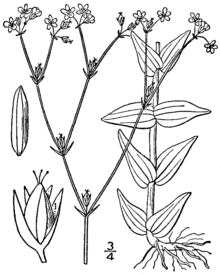 |
[99][21][100][101][120] |
| H. humbertii
Staner |
Perennial herb | Uganda, DRC, Rwanda, Burundi | [50][35] | ||
| H. japonicum
Thunb. |
Matted St. John's Wort | Annual herb | Asia, Oceania | 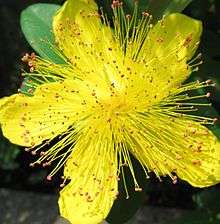 |
[136][61][78][129][132] |
| H. killipii
N.Robson |
Perennial herb | Colombia | [22][24] | ||
| H. lalandii
Choisy |
Perennial herb | Africa | [35][36][137][39][87] | ||
| H. majus
(A.Gray) Britton |
Greater Canadian St. John's Wort | Perennial herb | Canada, USA (Introduced to W. Europe) | [103][108][104][100][101] | |
| H. moranense
Kunth |
Perennial/annual herb | Mexico | [34][92] | ||
| H. mutilum
L. |
Dwarf St. John's Wort | Perennial/annual herb |  |
[103][62][104][120][106] | |
| H. oligandrum
Milne-Redh. |
Perennial/annual herb | DRC, Zambia, Angola, Namibia | [26][35][36][138][42] | ||
| H. parvulum
Greene |
Sierra Madre St. John's Wort | Perennial/annual herb | Mexico, Hawaii | [80][75][76][101][34] | |
| H. pauciflorum
Kunth |
Fewflower St. John's Wort | Subshrub/perennial herb | Mexico | [80][75][76][101][34] | |
| H. paucifolium
S. Watson |
Perennial herb | Mexico, United States | [76][34][92] | ||
| H. pedersenii
N.Robson |
Wiry shrublet | Brazil | [8][2] | ||
| H. philonotis
Schltdl. & Cham. |
Annual herb | Mexico, Guatemala, Honduras | [50][34][92][43] | ||
| H. pleiostylum
C. Rodr. Jim. |
Annual herb | Brazil | [22][126] | ||
| H. pratense
Schltdl. & Cham. |
Sanguinaria | Perennial/annual herb | Mexico, Central America | [34][88][15] | |
| H. pumilum
Sessé & Moc. |
Mexico | [26][126] | |||
| H. relictum
N.Robson |
Subshrub | Colombia | [2][126][26][24] | ||
| H. scioanum
Chiov. |
Perennial herb | Eastern Africa, DRC | [22][35][41] | ||
| H. thesiifolium
Kunth |
Perennial herb | Costa Rica, Panama, Venezuela, Colombia | [34][88][15][93] | ||
Sect. Tripentas
Tripentas (Casp.) N.Robson contains one long-stemmed perennial herb, H. elodes. Tripentas is sometimes separated into its own genus under the synonyms Elodes (Spach) W. Koch, Martia Sprengel, Perforaria Choisy, Spachelodes Y. Kimura, or Tripentas Casp.
| Binomial | Common Name | Type | Distribution | Image | References |
|---|---|---|---|---|---|
| H. elodes
L. (1759) |
Marsh St. John's Wort | Perennial herb |  |
 |
[40][21][61][81][60] |
Sect. Umbraculoides
Umbraculoides N.Robson contains a single species, H. umbraculoides, for which the section is named. It is closely related to sect. Ascyreia.[139]
| Binomial | Common Name | Type | Distribution | Image | References |
|---|---|---|---|---|---|
| H. umbraculoides
N.Robson (1985) |
Deciduous shrub | Mexico | [50][51][8][26] |
Sect. Webbia
Webbia (Spach) R. Keller contains a large deciduous shrub that can grow up to 4 meters tall.
| Binomial | Common Name | Type | Distribution | Image | References |
|---|---|---|---|---|---|
| H. canariense
L. (1753) |
Canary Islands St. John's Wort
Granadillo |
Shrub/Tree |  |
[80][18][62][101][106] |
Extinct
Hypericum fossils have been found from the Late Eocene to the present day, with the most commonly found part of the plant being the seeds due to their hardiness. However, a small number of leaves and even pollen have also been found as fossils. The oldest fossil recovered was a seed belonging to the species H. antiquum which was found in Northern Asia. This species is considered to be the common ancestor of the family Hypericaceae.[140]
| Binomial | Fossil Status | Temporal Range | Location | Distribution | References |
|---|---|---|---|---|---|
| H. antiquum
Balueva & Nikitin |
Seeds | Neogene | Russia (Siberia) | [140][141][139] | |
| H. canatalense
E. Reid |
Seeds | Pliocene | France | [141] | |
| H. coriaceum
Nikitin |
Seeds | Miocene | Russia | Europe | [141] |
| H. danicum
Friis |
Miocene | Denmark | [142][143][141] | ||
| H. foveolatum
Dorof. |
Seeds | Pliocene | Belarus | Europe | [141] |
| H. miocenicum
Dorof. |
Oligocene–Pliocene | [140] | |||
| H. holyi
Friis |
Middle Miocene | Denmark | [143][140] | ||
| H. rostriformum
Jakub |
Seeds | Miocene | Belarus | Europe | [141] |
| H. septestum
Nikitin ex Arbuzova |
Miocene | Czech Republic, Russia | [144][145][141] | ||
| H. tertiarium
Nikitin |
Oligocene–Pliocene | [140] |
References
- Nürk, Nicolai M.; Blattner, Frank R. (2010). "Cladistic analysis of morphological characters in Hypericum (Hypericaceae)". Taxon. 59 (5): 1495–1507. doi:10.1002/tax.595014 – via ResearchGate.
- "Hypericum". The Plant List. Royal Botanic Gardens, Kew, Missouri Botanical Garden. 2013. Retrieved 19 February 2016.
- Robson, N.K.B. (2002-10-31). "Studies in the genus Hypericum L. (Guttiferae) 4(2). Section 9. Hypericum sensu lato (part 2): subsection 1. Hypericum series 1. Hypericum". Bulletin of the Natural History Museum, Botany Series. 32 (2). doi:10.1017/s096804460200004x. ISSN 0968-0446.
- Nürk, Nicolai M.; Madriñán, Santiago; Carine, Mark A.; Chase, Mark W.; Blattner, Frank R. (2013-01-01). "Molecular phylogenetics and morphological evolution of St. John's wort (Hypericum; Hypericaceae)". Molecular Phylogenetics and Evolution. 66 (1): 1–16. doi:10.1016/j.ympev.2012.08.022. ISSN 1055-7903. PMID 23058779.
- "St. John's Wort, Hypericum | AquaPlant". aquaplant.tamu.edu. Retrieved 2018-07-31.
- "Nomenclature | Hypericum online". hypericum.myspecies.info. Retrieved 2018-01-25.
- Xiwen, Li; Robson, Norman (1994). Flora of China (PDF). Science Press & Missouri Botanical Garden. pp. 13: 2–35.
- "Hypericum Tourn. ex L." Plants of the World Online. Kew Science. Retrieved 2018-02-05.
- Brickell, Christopher (2008). A-Z encyclopedia of garden plants. Royal Horticultural Society (Great Britain) (3rd ed.). London: Dorling Kindersley in association with the Royal Horticultural Society. ISBN 9781405332965. OCLC 299238159.
- Szegedi, A.; Kohnen, R.; Dienel, A.; Kieser, M. (2005-03-05). "Acute treatment of moderate to severe depression with hypericum extract WS 5570 (St John's wort): randomised controlled double blind non-inferiority trial versus paroxetine". BMJ (Clinical Research Ed.). 330 (7490): 503. doi:10.1136/bmj.38356.655266.82. ISSN 1756-1833. PMC 552808. PMID 15708844.
- Klemow, Kenneth M.; Bartlow, Andrew; Crawford, Justin; Kocher, Neil; Shah, Jay; Ritsick, Michael (2011). Benzie, Iris F. F.; Wachtel-Galor, Sissi (eds.). Medical Attributes of St. John's Wort (Hypericum perforatum). Herbal Medicine: Biomolecular and Clinical Aspects (2nd ed.). Quattrocchi 2016 Press/Taylor & Francis. doi:10.1201/b10787-12. ISBN 9781439807132. PMID 22593920. Retrieved 2018-09-24.
- Ernst, Edzard (2003). Hypericum: The genus Hypericum. Quattrocchi 2016 Press. p. 9. ISBN 978-1420023305.
- "Flora Europaea : Hypericum". rbg-web2.rbge.org.uk. Retrieved 2018-08-03.
- "Hypericum: Royal Horticultural Society". www.rhs.org.uk.
- "Genus: Hypericum L". GRIN. Germplasm Resources Information Network. Retrieved 2018-06-08.
- Franklin, Gregory; Beerhues, Ludger; Čellárová, Eva, eds. (2017). Molecular and Biotechnological Advancements in Hypericum Species. Frontiers Research Topics. doi:10.3389/978-2-88945-117-3. ISBN 9782889451173. ISSN 1664-8714.
- Djordjevic, Aleksandra; Lazarevic, Jelena; Mitic, Violeta; Palic, Radosav; Stojanovic, Gordana (2013). "Antimicrobial activity of Hypericum annulatum moris and Hypericum elegans stephan ex willd. essential oils from Serbia" (PDF). Chemical Industry and Chemical Engineering Quarterly. 19 (1): 7–11. doi:10.2298/ciceq120111036d. ISSN 1451-9372.
- "The Euro+Med Plantbase Project". ww2.bgbm.org. Retrieved 2018-08-03.
- "Hypericum". Alpine Garden Society Plant Encyclopedia. 2011. Retrieved 2018-06-08.
- "Plant of the Month: Hypericum athoum". Ontario Rock Garden and Hardy Plant Society. Retrieved 2018-06-08.
- "Hypericum Taxonomic Classification". European Environment Agency (EUNIS).
- "!Hypericum L". Tropicos. Missouri Botanical Garden. Retrieved 24 May 2018.
- "Hypericum [family HYPERICACEAE]". JSTOR Global Plant. Retrieved 2018-08-10.
- "Global Species : Hypericum". globalspecies.org. Retrieved 2018-09-24.
- "Türkiye Bitkileri Listesi // bizimbitkiler.org.tr - Nezahat Gökyiğit Botanik Bahçesi - 2013". www.bizimbitkiler.org.tr. Retrieved 2018-12-21.
- "Hypericum". eElurikkus. 2018-05-20. Retrieved 2018-07-31.
- "Hızlı Arama Sonuçları". Türkiye Bitkileri Veri Servisi (Tubives) (in Turkish). Retrieved 2018-07-08.
- "Hypericum". Flora of Cyprus. Retrieved 2018-06-08.
- Danin, Avinoam. "Analytical Flora: Hypericum". Flora of Israel Online. Retrieved 2018-06-08.
- "Flowers - St. John's-wort Family". NatureGate. Retrieved 2018-06-08.
- "Hypericum". Henriette's Herbal Homepage. Retrieved 2018-08-11.
- Aguilar, Marcelino J. del Arco (2018). Vegetation of the Canary Islands. Springer. ISBN 9783319772554.
- "PESI Portal - Hypericum L". EU-Nomen. Retrieved 2018-08-06.
- "Hypericaceae Species List". SEINet Arizona-New Mexico Chapter. Retrieved 2018-06-08.
- "Hypericum L". CJB African Plant Database. Conservatorie et Jardin Botaniques Ville de Geneve. Retrieved 2018-06-08.
- "Hypericum Accepted Species". Arquivo Cientifico Tropical Digital Repository (ACTD). IICT. Retrieved 2018-08-09.
- Jacobus, Botha, C.J. (Christoffel; Elna, Venter (2002). "Hypericum species". hdl:2263/8502. Cite journal requires
|journal=(help) - "5168.000 Hypericum L". Flora of Zimbabwe. Retrieved 2018-08-11.
- "5168.000 Hypericum L". Flora of Mozambique. Retrieved 2018-08-11.
- "The IUCN Red List of Threatened Species". www.iucnredlist.org. Retrieved 2018-07-31.
- "5168.000 Hypericum L". Flora of Malawi. Retrieved 2018-08-11.
- "5168.000 Hypericum L". Flora of Zambia. Retrieved 2018-08-11.
- "Hypericum L. [Guttiferae-Hypericoideae]". Botanical Illustrations. Retrieved 2018-08-11.
- "Hypericum". www.floradecanarias.com. Retrieved 2018-10-03.
- "Hypericum L". GBIF. Global Biodiversity Information Facility. 2018-03-25. Retrieved 2018-04-22.
- Quattrocchi, Umberto (2016). Quattrocchi 2016 World Dictionary of Medicinal and Poisonous Plants: Common Names, Scientific Names, Eponyms, Synonyms, and Etymology. Quattrocchi 2016 Press. ISBN 978-1482250640.
- Mifsud, Stephen (2002-08-23). "Hypericaceae Family Profile". Wild Plants of Malta. Retrieved 2018-08-06.
- "Hypericum scruglii, flora di Sardegna". www.sardegnaflora.it (in Italian). Retrieved 2018-10-03.
- Bacchetta, Gianluigi; Brullo, Salvatore; Salmeri, Cristina (2010-05-06). "Hypericum scruglii sp. nov. (Guttiferae) from Sardinia". Nordic Journal of Botany. 28 (4): 469–474. doi:10.1111/j.1756-1051.2009.00736.x. hdl:10447/51543. ISSN 0107-055X.
- Zicha, Ondrej. "BioLib: Biological library". www.biolib.cz. Retrieved 2018-01-25.
- "Catalogue of Life - 2014 Annual Checklist :: Taxonomic tree". www.catalogueoflife.org. Retrieved 2018-07-31.
- Nicolai, Nurk; Blattner, Frank (1967). "Cladistic analysis of morphological characters in Hypericum (Hypericaceae)". Not. Roy. Cure. Gard. Edinb. 27 (5): 197. JSTOR 20774044.
- Koray; Kurtulus; Okan; Gökhan; Dervis; Onur (2013). "Anatomical studies and conservation status of rare endemic Hypericum sechmenii Ocak&Koyuncu (Sect: Adenosepalum) from EskişehirTurkey". ResearchGate (Scientific Journal).
- Ocak, Atila; Savaroglu, Filiz; Potoğlu Erkara, İsmuhan; Koyuncu, Onur (2009). "Hypericum sechmenii(Hypericaceae), a New Species from Central Anatolia, Turkey". Annales Botanici Fennici. 46 (6): 591–594. doi:10.5735/085.046.0616. ISSN 0003-3847.
- Nurk, Nicolai (2011). Phylogenetic analyses in St. John's wort (Hypericum): Inferring character evolution and historical biogeography (PDF) (Dissertation). Berlin. pp. 32, 110. Retrieved 2018-04-22.
- "Hypericum". deeproot.co.uk. Retrieved 2018-07-06.
- Ker, John Bellenden (1817). "Egyptian St. John's-wort". Botanical Register. 3 – via JSTOR.
- "Hypericum aegypticum, Dwarf St. John's Wort, Shrub". SanMarcos Growers. Retrieved 2018-08-06.
- Sydenham, Edwards (1817). The Botanical register: consisting of coloured figures of exotic plants. 3. p. 196.
- "A to Z Thumbnail Index". UK Wildflowers. Retrieved 2018-08-11.
- "NSW Flora Online". PlantNET. National Herbarium of New South Wales. Retrieved 2018-08-07.
- "Calflora: Plant Search". www.calflora.org. Retrieved 2018-01-11.
- "Hypericaceae - Hypericum". eFloras of India.
- "Plant List by Genus". Landscape Plants. Oregon State University. Retrieved 2018-08-07.
- Bramwell, David (1976), "The Endemic Flora of the Canary Islands; Distribution, Relationships and Phytogeography", Biogeography and Ecology in the Canary Islands, Monographiae Biologicae, 30, Springer Netherlands, pp. 207–240, doi:10.1007/978-94-010-1566-0_6, ISBN 9789401015684
- "Bean's Trees and Shrubs". www.beanstreesandshrubs.org. Retrieved 2018-08-07.
- Bramwell, D; Bramwell, Z (1974). Wild Flowers of the Canary Islands. Stanley Thornes (Publishers) Ltd.
- Scönfelder, P; Scönfelder, I (2005). Die Kosmos Kanarenflora. Kosmos.
- La biodiversidad en Guanajuato: estudio de Estado. México: Comisión Nacional para el Conocimiento y Uso de la Biodiversidad (CONABIO). 2011. doi:10.5962/bhl.title.118977.
- Lenton, Steve. "Cretan Flora". www.cretanflora.com. Retrieved 2018-08-25.
- Crockett, Sara; Robson, Norman (2011-01-01). "Taxonomy and Chemotaxonomy of the Genus Hypericum". Medicinal and Aromatic Plant Science and Biotechnology. 5 (Special Issue 1): 1–13. PMC 3364714. PMID 22662019.
- Engler, Adolf (1898). Die Natürlichen Pflanzenfamilien, nebst ihren Guttungen und wichtigeren Arten, Volume 1. W. Engelmann.
- "Hypericum". eFloras of China. Retrieved 2018-08-11.
- "Online Plant Guide Search". onlineplantguide.com. Retrieved 2018-08-10.
- "Plants Profile for Hypericum". USDA Plants.
- "ITIS Standard Report Page: Hypericum". www.itis.gov. Retrieved 2018-01-13.
- "Hypericum Plants". findmeplants. Retrieved 2018-08-10.
- "Plants for a Future". pfaf.org. Retrieved 2018-06-08.
- "Hypericum Species: Common St. John's wort & Aaron's Beard" (PDF). Garry Oak.
- "Family: Clusiaceae, Genus: Hypericum". davesgarden.com. Retrieved 2018-01-04.
- "Plant Finder". Online Atlas of the British and Irish Flora. Retrieved 2018-06-08.
- Murthy, K; Rama, S; Rani, S; Pullaiah, T (2004). "Hypericum gaitii Haines (Hypericaceae), a new record for southern peninsular India". J. Bombay Nat. Hist. Soc. 101: 189–191.
- Biswas, SN (1972). "Hypericum griffithii Hook. F. et Thoms, ex Dyer emend. S. N. Biswas - a noteworthy flowering plant from eastern Himalayas". Bull. Bot. Surv. India. 13: 160–161.
- Sahni, KC; Naithani, HB. "Hypericum griffithii Hook. f. et Thoms. ex Dyer: a very rare shrub from Arunachal Pradesh". Indian Forester. 106: 865–868.
- "Plant Finder". www.missouribotanicalgarden.org. Retrieved 2018-09-16.
- "Hypericum | Flora Malesiana". portal.cybertaxonomy.org. Retrieved 2018-09-09.
- "PROTA4U Database". Plant Resources of Tropical Africa - PROTA Database. Retrieved 2018-08-23.
- "Hypericum spp". Herbario Virtual Austral Americano. Retrieved 2018-06-08.
- "Invasive Species Compendium". CABI. 2018. Retrieved 2018-08-11.
- "HYPERICUM SEEDS - Plant World Seeds". www.plant-world-seeds.com. Retrieved 2018-05-21.
- "Hypericum uralum". www.icimod.org. Retrieved 2018-08-23.
- "Plant ID Tools". Field Museum. Retrieved 2018-07-08.
- "Hypericum". eFloras Bolivia Checklist. Retrieved 2018-08-11.
- Elenevskii, AG; Zernov, AS (2000). "Zametka o Hypericum strictum (Hypericaceae) i blizkikh vidakh. (Note on Hypericum strictum (Hypericaceae) and allied species.)". Bot. Zhurn. 85: 52–55.
- "HYPERICUM". www.botany.cz. Retrieved 2018-10-03.
- "Hypericum L". eFloras of Chile. Retrieved 2018-08-11.
- Reiche, K. Estudios críticos sobre la flora de Chile (PDF) (in Spanish). Universidad de Chile. pp. 269–270. doi:10.5354/0717-8883.2012.24671 (inactive 2020-06-04).
- Team, OneZoom. "OneZoom Tree of Life Explorer, text page for St. John's wort". www.onezoom.org. Retrieved 2018-10-03.
- "Hypericum - Genus Page - ISB: Atlas of Florida Plants". florida.plantatlas.usf.edu. Retrieved 2018-04-14.
- "Lady Bird Johnson Wildflower Center". University of Texas at Austin. Retrieved 2018-08-06.
- "Genus: Hypericum". NatureServe Explorer. 2009-02-02. Retrieved 2018-08-06.
- "Yellow Flowers". Missouri Plants. Retrieved 2018-06-08.
- "Hypericum - Michigan Flora". michiganflora.net. Retrieved 2018-01-04.
- "Genus: Hypericum: Go Botany". gobotany.nativeplanttrust.org. Retrieved 2018-01-13.
- Nürk, Nicolai M.; Crockett, Sara L. (2011). "Morphological and Phytochemical Diversity among Hypericum Species of the Mediterranean Basin". Medicinal and Aromatic Plant Science and Biotechnology. 5 (Special Issue 1): 14–28. ISSN 1752-3389. PMC 3364718. PMID 22662020.
- "UC/JEPS: Jepson Manual treatment for HYPERICUM". ucjeps.berkeley.edu. Retrieved 2018-08-01.
- Xi-chun, Du; Yi, Ren (2005). A New Species of Hypericum (Clusiaceae) from Shaanxi Province, China (PDF). Xi’an, People’s Republic of China: College of Life Sciences, Shaanxi Normal University. pp. 274–276.
- "'Hypericum': Minnesota Wildflowers". Retrieved 2018-01-13.
- Borisova, IV; Vernik, RS; Norbobaeva, T (1989). "Nekotorye biologicheskie osobennosti Hypericum scabrum (Hypericaceae) v zapadnom Tyan-Shane". Bot. Zhurn. 74: 982–994 – via Hypericum MySpecies.
- Hayata, B. (June 20, 1911). "Hypericineae". Journal of the College of Science, Imperial University of Tokyo. 30 (1): 38–39 – via Biodiversity Heritage Library.
- Kato, T. "Taxonomical studies on the Hypericum pseudopetiolatum complex: 2. Natural hybridizations in Kyushu". Bull. Nation. Sci. Mus., B (Tokyo). 12: 139–149.
- Kato, T (1987). "Taxonomical studies on the Hypericum pseudopetiolatum complex: 3. Taxonomy". Bull. Nation. Sci. Mus., B (Tokyo). 13: 69–80.
- "Hypericum | Emorsgate Seeds – (01553) 829 028". wildseed.co.uk. Retrieved 2018-08-03.
- Klemow, Kenneth; Bartlow, Andrew; Crawford, Justin; Kocher, Neil; Shah, Jay; Ritsick, Michael (2011-03-28), "Medical Attributes of St. John's Wort (Hypericum perforatum)", Oxidative Stress and Disease, CRC Press, pp. 211–237, doi:10.1201/b10787-12, ISBN 9781439807132
- "Species: Hypericum perforatum". www.fs.fed.us. Retrieved 2018-12-18.
- Oterino, A.; Lainz, M. (1997). "Sobre Hypericum tetrapterum Fr. e H. undulatum Schousb. ex Willd. en Asturias". An. Jard. Bot. Madrid. 55: 161–163.
- "Native Shrubs of Texas Database Search". aggie-horticulture.tamu.edu. Retrieved 2018-07-31.
- "Trees, Shrubs, and Woody Vines of North Carolina". www.carolinanature.com. Retrieved 2018-08-01.
- Weakley, Alan S. (2015). Flora of the Southern and Mid-Atlantic States (PDF). UNC Herbarium, North Carolina Botanical Garden, University of North Carolina at Chapel Hill. pp. 696–704.
- "Wildflowers of Illinois". Illinois Waterflowers. Retrieved 2018-06-08.
- Wilhelm, Gerould; Rericha, Laura (2016). "A new species of Hypericum (Hypericaceae) and some new combinations in the vascular flora of the Chicago Region" (PDF). The Michigan Botanist. 55: 89–96.
- Rericha, Laura; Wilhelm, Gerould (2017). Flora of the Chicago Region: A Floristic and Ecological Synthesis.
- "Online Virtual Flora of Wisconsin - Hypericum". wisflora.herbarium.wisc.edu. Retrieved 2018-11-10.
- Rouet, JM (1979). "Hypericum australe dans le Var". Monde Pl. 74: 5.
- Puntieri, JG; Brion, CAM. "Hypericum humifusum (Clusiaceae), nueva especie adventicia en la Argentina. [Hypericum humifusum (Clusiaceae). new adventive species in Argentina.]". Hickenia. 3: 293–296.
- Barker, Christine. "The International Plant Names Index - home page". ipni.org. Retrieved 2018-09-16.
- Assadi, M. (1984). "New species and new plant records from Iran". Iranian J. Bot. 2: 83–93 – via AGRIS.
- Biswas, SN (1971). "Hypericum assamicum S.N.Biswas (Hypericaceae) a new species from eastern Himalaya". Webbia. 25 (2): 671–674. doi:10.1080/00837792.1971.10669945.
- "Hypericum". Dinghushan Plant Checklist. Chinese Academy of Sciences. Retrieved 2018-08-11.
- Faulkner, JS (1990). "A Co Armagh (H37) site for Hypericum hirsutum L". Irish Nat. J. 23: 283–284.
- Meyer, FK (1978). "Hypericum haplophylloides Hal. et Bald. - eine seltene Pflanze der westlichen Balkan-Halbinsel". Wissenschaft. Zeitschr. Friedrich-Schiller-Univ., Math.-Naturwiss. 27: 67–78.
- "Hypericum - Useful Tropical Plants". tropical.theferns.info. Retrieved 2018-08-23.
- "Plant Profile: Hypericum cumulicola". Center for Plant Conservation. Retrieved 2018-07-08.
- Menges, Eric (2008). Highland Scrub Hypericum: Hypericum cumulicola 5-Year Review. Vero Beach, Florida: U.S. Fish and Wildlife Service.
- Burns, James; Cusick, Allison. "HYPERICUM BOREALE (Britt.) Bickn" (PDF). Nature Preserves of Ohio.
- Khan, AA; Agrawal, S; Khan, A. "Hypericum japonicum Thunb. ex Murr. - a new record for Uttar Pradesh from Hastinapur Wildlife Sanctuary". J. Econ. Taxon. Bot. 30: 697–698.
- "5168.000 Hypericum L". Flora of Botswana. Retrieved 2018-08-11.
- "5168.000 Hypericum L". Flora of Caprivi. Retrieved 2018-08-11.
- Meseguer, Andrea S.; Lobo, Jorge M.; Cornuault, Josselin; Beerling, David; Ruhfel, Brad R.; Davis, Charles C.; Jousselin, Emmanuelle; Sanmartín, Isabel (January 2018). "Reconstructing deep-time palaeoclimate legacies in the clusioid Malpighiales unveils their role in the evolution and extinction of the boreotropical flora" (PDF). Wiley Global Ecology and Biology. 27 (5): 616–628. doi:10.1111/geb.12724.
- Meseguer, Andrea (March 2015). "Integrating Fossils, Phylogenies, and Niche Models into Biogeography to Reveal Ancient Evolutionary History: The Case of Hypericum (Hypericaceae)". Systematic Biology. 64 (2): 215–232. doi:10.1093/sysbio/syu088. PMC 4380036. PMID 25398444.
- "Hypericum: Nomenclatural Status". fossilplants.info. Retrieved 2018-09-28.
- Meseguer, Andrea; Sanmartin, Isabel (June 2012). "Paleobiology of the genus Hypericum (Hypericaceae): A survey of the fossil record and its palaeogeographic implications". Anales del Jardín Botánico de Madrid. 69 (1): 97–106. doi:10.3989/ajbm.2306 – via ResearchGate.
- Friise, Else Marie (1985). "Angiosperm Fruits and Seeds from the Middle Miocene of Jutland (Denmark)" (PDF). Det Kongelige Danske Videnskaberne Selskab Biologiske Skrifte. 24: 3.
- F., Holý; Z., Kvaček; V., Teodoridis (2012). Review of the Early Miocene Mastixioid Flora of the Kristina Mine at Hrádek nad Nisou in North Bohemia (The Czech Republic). Praha. ISSN 0036-5343.
- Nikitum, P. A. (1957). "Materials to the knowledge of the Western Siberian Tertiary flora (fossil flora of Ekaterininskoe village near Tara town)". Fossil Plants. p. 307.